Is Congress Right About TikTok?



To celebrate a once in a lifetime experience, Greenhill and Bucknell University worked together to dedicate half a school day to observe the solar eclipse along with a campus astronomy fair.
Held on April 10, the fair featured 10 stations for each of the eight planets, the sun and moon. Activities at each station ranged from viewing the sun through a Coronado telescope, crafting a model of the sun, moon and Earth and drawing the sun throughout the eclipse using a Sunspotter.
A total solar eclipse is one of the rarest natural phenomena, as it requires the moon’s orbit to completely cover the sun. It had been almost 150 years since North Texas experienced a total solar eclipse, and there won’t be another one until the year 2317.
Given the historical and scientific significance, Greenhill devoted several hours to the eclipse so that all students, teachers and staff could witness the few minutes of total darkness as the moon passed over the sun. The partial eclipse began at 12:20 p.m. and it reached totality from 1:40-1:44 p.m. After totality, the partial eclipse remained until 3 p.m.
The Evergreen gathered reactions from faculty and students during the event, and here is some of what they had to say:
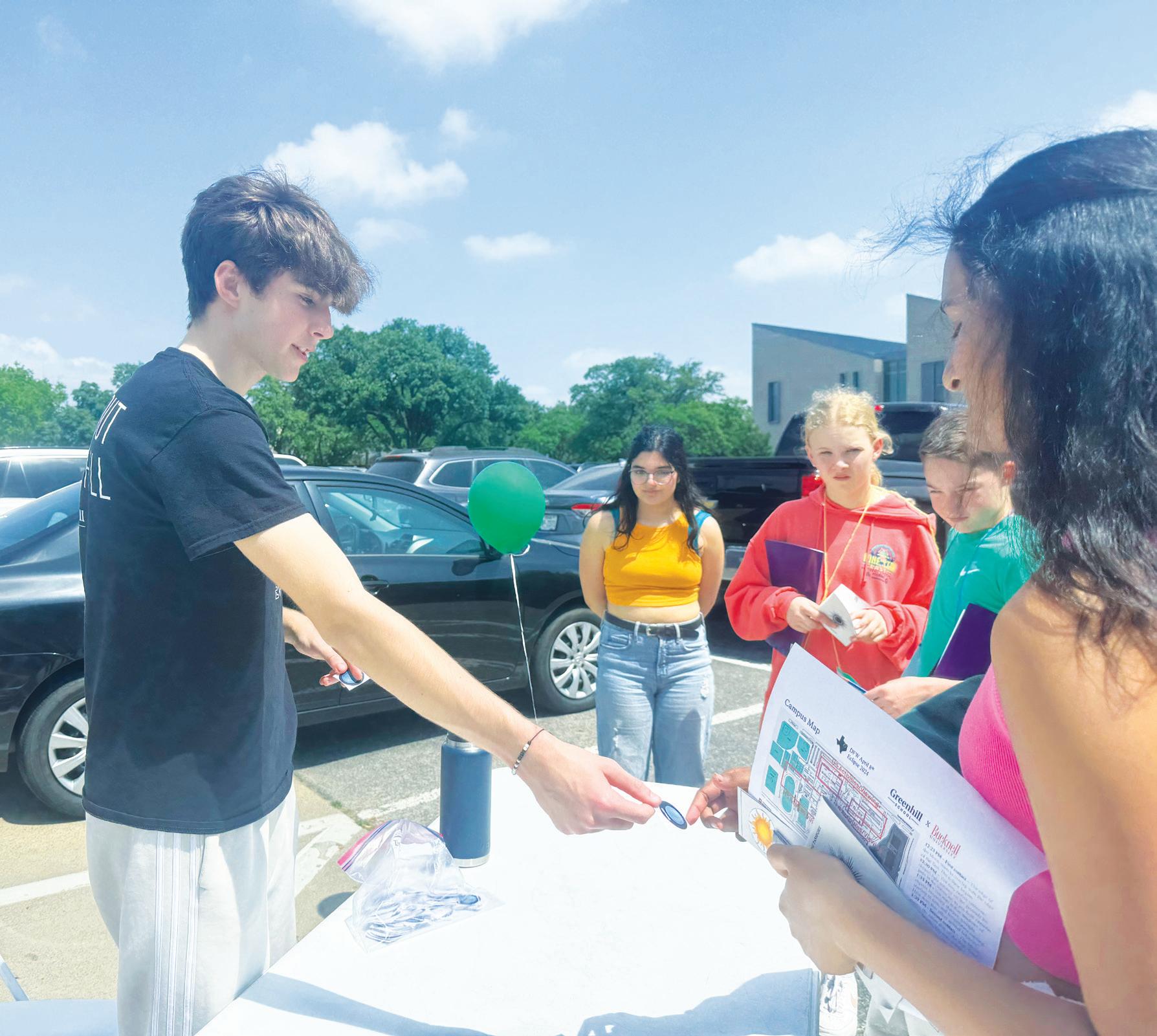
“I led the scale model [station] with a big weather balloon and M&Ms to scale the distance of the Earth to the sun. Overall, it was a good experience, and I had a lot of fun working with the Bucknell students because they were all super nice, inclusive and also knowledgeable. I could just ask them any questions, and they’d be enthusiastic to explain and help me understand.”
– junior Alden Kendall
“As the astronomy fair started to materialize, we really saw the excitement around it as an opportunity to showcase science. We also wanted to get students to look up from the screens and think about the natural world around us, what could be causing [the solar eclipse] and just get excited about space studies.”
– Upper School Science Department Chair Treavor Kendall

“I ran the station that was simulating the three subtypes of a solar eclipse: partial eclipse, total solar eclipse and annular eclipse. I had a small yoga ball that represented the moon, and further down I had a larger weather balloon that represented the sun. Then I told people to stand at different points to get all three perspectives of an eclipse.”


“My favorite part of running this station was seeing all of these people looking through the telescope and being in awe of what they saw. Even the people from SAGE [Dining Services] came over, so it was a really nice and a community moment for people to see something really cool.”
– junior Saida Bidiwala
“I was in charge of the Sunspotter station where I explained how the Sunspotter takes the light from the sun and focuses it to make an image of the sun and its sunspots. But for the eclipse, it was really cool because you can see how over time the moon was eclipsing the sun and you could see the progression of that cycle without having to look up into the sky.”
– sophomore Maya Jagsi
– junior Aneesh Mootha

Last November, juniors Ana Blankson and Madi McClellan decided to apply for a highly selective educational mentoring program called the Disney Dreamers Academy.
Each year, only 100 students are chosen for the academy from thousands of applicants.
“I knew it was a long shot, but the opportunity sounded too exciting to not apply,” said Blankson.
The applications that Blankson and McClellan submitted described their personal journeys and future dreams. In January, the two Upper School students received emails notifying them that they had been accepted for the program.
“When I found out I was accepted into the academy I felt a combination of emotions, mostly excitement and shock,” said McClellan. “It felt surreal opening the package from Disney and seeing myself posted on the Instagram.”
The Disney Dreamers Academy was first hosted in 2008. Its main goal is “to give students with a dream the tools it takes to let their potential shine through,” according to the program website.
Since then, 100 high school students who are 13-16 years old and from historically underrepresented communities are invited to attend the academy in Orlando. For three days, academy attendees participate in interactive career workshops, motivational talks and networking opportunities to better prepare them for the future.
professional in your specific career path,” said Blankson. “Mine was Daymond John from Shark Tank and just hearing about his journey motivated me.”
While the program’s itinerary was primarily geared toward learning, the students also had plenty of time to enjoy three parks – Animal Kingdom, Epcot and Magic Kingdom – within the Walt Disney World Resort.
“There was an academic and more professional aspect,” said McClellan. “But there was also a really fun aspect.”
Both Blankson and McClellan discovered the program through previous participants.
“[My cousin], who went for graphic design, told me it was one of the best experiences she has ever had, and how much she learned about the field,” said Blankson.
Students have the option to apply to several career paths, including business, entertainment and sciences.
“I applied to the entrepreneurship program because I wanted to figure out how I can convert companies right now into ones that can give back to their communities,” said Blankson.
There were also other career paths offered. For example, McClellan attended the program’s pre-law track. Along with learning more about this profession, McClellan met distinguished adults in her prospective field.

One thing that separates the program from other mentorship programs is the professional expertise available to students.
“We’d have deep dive sessions, which is talking to a
Sydney ChienG“We worked with a Disney attorney,” said McClellan. “She taught us about what she does, about different types of law and we did a mock settlement.”
Blankson gained new insights from the program about finding her career path. “I learned that there isn’t always a straight line to where you want to be,” said Blankson. “There might not be a job title for what you want to do and you kind of just have to create it by talking to people, connecting with people and starting with a firm handshake.”
During the program, Blankson and McClellan interacted with other impressive students their age.

“Other kids there were entrepreneurs, founders, nonprofit starters and published authors,” said McClellan. “I remember talking to a girl who had a radio show.”
McClellan says she enjoyed the opportunity to work and network with the talented mentors and peers.
“Being around these really motivated people who push themselves past what the average teenager does has really encouraged me to improve myself,” said McClellan.
Blankson says that she returned home feeling inspired and with a new mindset.
“I realized that it’s never too late to have an idea and start something” said Blankson. “It is also never too late to have an idea and to want to be successful while still giving back to your community.”
reenhill’s third annual Integration Bee garnered a record amount of attention from Upper School students, attracting math enthusiasts and fans alike. Twenty-six students competed in this year’s event, which was held in the Lecture Hall during Hornet blocks. Over three days, each student competed in one-on-one elimination rounds that culminated in a final round.
The final round featured seniors Aditya Pulipaka and Dibyadeep Saha, with Pulipaka claiming the first-place
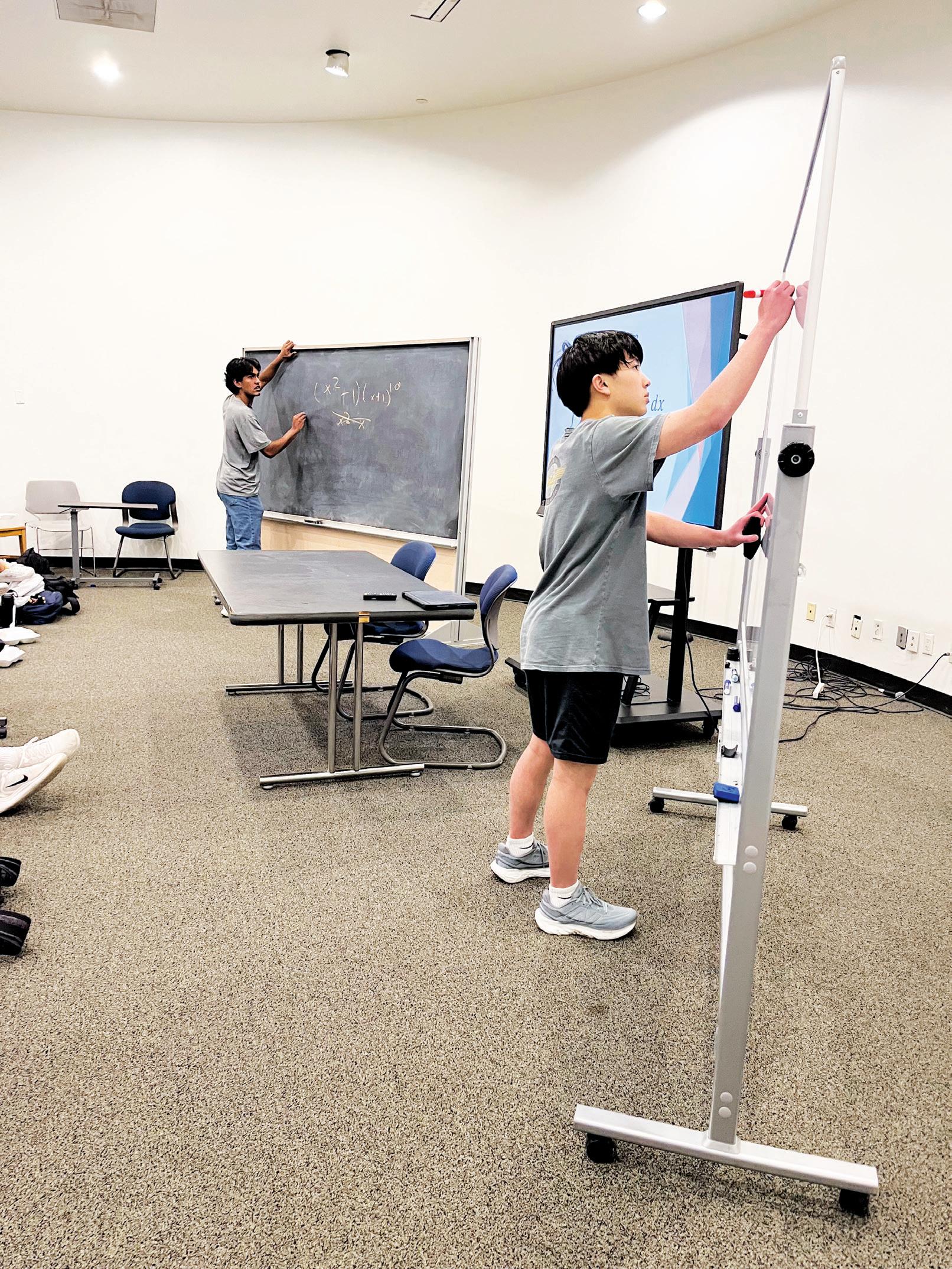
victory.
“I think there’s always room for improvement, but overall, I’m content with how I performed and leaving the Upper School on a good note,” said Pulipaka.
The tradition began a few years ago when students Tim Nadolsky ’22 and Kevin Han ’23 approached Math Club cosponsor Jessica Chu with the idea. Nadolsky and Han had seen an Integration Bee hosted at colleges. The pair created questions and refined the rules, and the first Greenhill Integration Bee came to fruition in 2022.
Creating questions is one of the hardest aspects of organizing the bee, according to Chu.
“The bulk of the work is finding the questions and making sure they are at an appropriate level of difficulty,” said Chu. “Then, because it’s all single-elimination rounds, you want [the questions] to go from easy to hard.”
The Math Club leaders talked to Upper School Dean of Students Jack Oros to ensure that competitors could cut the lunch line and get to-go boxes so they could make it to their rounds on time. They also put together a sign-up form and randomized the draw.
Many of this year’s participants also competed last year. This includes Saha, who says he decided to prepare for this year’s competition.
“[Last year,] I had no preparation, and I wasn’t even aware it was happening until like a day before doing it, so I wound up with no preparation and didn’t do very well,” said Saha. “Because of that I was like, ‘okay, you know what, we’re going to be prepared this time.’”
Many other competitors prepared ahead of time as well. Math Club leaders began advertising for the bee at the end of February. Aside from increased preparation time for competitors, this allowed excitement and anticipation to build around the bee among the student body.
For instance, prior to the start of the competition a group of students analyzed the bracket and made predictions on the @ghintegration_bee Instagram account. One of their analysis videos amassed over 1,600 views.
Senior Anwar Battikhi, who helped run the Instagram account, says their goal was to increase student engagement.
“I think in general the Integration Bee is one of the
more exciting things Greenhill does every year, but people don’t always get into it because it’s math,” said Battikhi. “We thought that if we could figure something out that helps engagement, that will encourage more people to join in the future.”
Chu says the turnout in the Lecture Hall was the most she has ever seen at an Integration Bee.
“I felt like a lot more people were coming out to cheer on their friends, which was great, and I felt that the audience was excited and cheered for whenever someone got a question right or supported whenever someone was stuck,” said Chu. “I also liked how the audience wanted to try the problem too, although sometimes they tried a little too loud.”
Ultimately, the goal of the Integration Bee is to increase engagement and participation in math.
Math Club co-sponsor Melissa Battis proposed that future Integration Bee competitions could be held in the social staircase area of the Valdes STEM + Innovation Center to attract more attention.
I think in general the Integration Bee is one of the more exciting things Greenhill does every year, but people don’t always get into it because it’s math. We thought that if we could figure something out that helps engagement, that will encourage more people to join in the future.”
Additionally, Pulipaka says that Math Club is trying something new this year with the Geometry Bee.
“The Integration Bee requires you to know how to integrate and so only BC [calculus] and Vector kids, as of now, know all the integration tactics,” said Pulipaka. “I’m sure some people in lower grades were like, ‘Man, I wish I was part of this.’ So, this year we’re trying to get the Geometry Bee started and that should get more of the younger kids involved.”
The new Valdes STEM + Innovation Center has an array of dazzling features, ranging from a coffee shop to well-lit and modern research spaces. But, the building’s all-user bathrooms have gotten mixed reviews.
There are three all-user bathrooms in the building with full-length, locking doors and a common sink area. Elsewhere, there are four single-user, all-user bathrooms. One of the new features of these bathrooms is that they are shared by Middle and Upper School students and faculty.
Administrators say the bathrooms provide flexibility to the building, but students and parents have raised concerns about privacy and safety because of their co-ed nature. Another concern raised by Upper School students and faculty is the lack of menstrual products, which have been a feature in other Upper School bathrooms marked for female use.
The concerns have been manifested in the form of emails and a petition bearing more than 100 signatures presented to Head of School Lee Hark, students and parents said.
After an initial flurry of opposition to the bathrooms, the controversy has eased in recent days.
“[These bathrooms] were not intended to be a political statement,” said Hark. “Really, it was about where architectural design is headed. We believe that our students will adapt to it well. There are some kinks to work out because it’s new for us, but we’ll work those out. We’re going to be gathering data from students about their experiences in the restrooms to get a sense of how it’s working.”
Administrators say the new bathrooms are not only an effort to create an inclusive community, but evidence of new architectural trends.
“I think it’s a change to come in architecture,” said Associate Head of School and Chief Financial Officer/Chief Operating Officer Kendra Grace. “The bathrooms weren’t a
statement; they were an evolution of architecture and where design is going.”
Grace and Hark also say the bathrooms are an efficient use of space and an important design feature in the new building.
“We wanted the building to be flexible, and I think the bathrooms reflect that as well,” said Hark. “We also want those spaces to be safe and comfortable.”
But when the VSI opened in mid-March, some students and parents immediately raised concerns about individual privacy and safety within the bathrooms because of the shared facilities among genders and age groups.
According to Hark, several parents emailed him to express concerns about the new bathrooms. Others conveyed their concerns in a petition signed by 106 parents across school divisions, according to one Greenhill parent who asked to remain anonymous.
In an email the petition signatories sent to Hark, parents asked that the VSI bathrooms be changed to gender-specific to alleviate the “significant discomfort for students who choose to identify by gender.” The parents also said they had discussed the matter with a “pediatric medical professional” who described the VSI bathrooms as “inappropriate in a school setting as it does not allow for a safe space.”
In a March 26 email to parents and faculty, Hark addressed the concerns and invited community members to a tour of the building to view the bathrooms.
Responding to parental concerns about the bathrooms putting some students at risk for inappropriate behavior, Hark wrote that “we have had single-user restrooms on our campus for many years but have not experienced these kinds of incidents. In fact, this design is much safer and easier to administrate than the traditional multiple stalls behind a closed door.”
Hark says the parents who attended the March 28 tour seemed more receptive to the design.
“My sense was that the people who checked out the restrooms seemed to think that once they had seen them, that they weren’t that big of a deal,” said Hark.
Additional student and faculty concerns focused on the fact that menstrual products were not being provided in the new bathrooms. In other Upper School women’s bathrooms, menstrual products are readily available on the countertops.
After an Upper School town hall meeting with Hark on April 4, freshman Natalie Lugo sent a survey to students seeking opinions about the lack of menstrual products. She says she shared the results with Hark.
Hark subsequently announced that the school will provide menstrual products in the VSI bathrooms.
Despite the initial concerns about the bathrooms, community members say they are adjusting to them.
“The first day that I was in there it was a little awkward just because I wasn’t used to it, but now I’m totally comfortable with it,” said Lugo.
On May 1, Hark sent an email to families and staff addressing the feedback he had received about the bathrooms. He said the administration would make two immediate changes.
First, menstrual products would be accessible in both main VSI bathrooms. Second, the signage in the bathrooms would be changed from “All-Gender Restroom” to “All-User Restroom” to be “more consistent with similar facilities in other buildings across campus,” Hark wrote.
Director of Equity and Inclusion Monsie Muñoz ’05 says she thinks that people will become more used to the bathrooms as time passes.
“I see the rest of this academic year as us trying out this space,” said Muñoz. “And I think that’s fair for us to do, but we should be keeping track of [thoughts] that are coming up surrounding the bathrooms.”
atalyst Coffee opened for Greenhill faculty and students on April 12 inside the new Valdes STEM + Innovation Center.
The shop’s soft opening was April 9. Faculty and students browsed inside from 9-11 a.m. as a preview.
Catalyst is now open from 7:30 a.m.- 4 p.m. on weekdays for students and staff. The menu was created by the Australian company LDU Coffee and features an assortment of pastries, coffee and teas.
A coffee shop was always the plan for the new STEM center. However, the logistics of making that a reality required trial and error, according to Associate Head of School Kendra Grace, who also serves as Greenhill’s chief financial officer and chief operating officer.
“[Head of School Lee] Hark knew he wanted a coffee shop in the new building from the beginning,” said Grace. “It’s a new way to foster community.”
As part of the planning process, Grace and Director of Operations and Logistics Crystal Dixon went to Houston to visit the coffee shop at Kinkaid School.
“Ms. Dixon and I went down to Kinkaid, and we saw their coffee shop,” said Grace. “We liked their concept and
Aknew we wanted to expand on it.”
After months of interviewing and research, the decision was made to partner with LDU and SAGE Dining Services, to create Catalyst Coffee, according to Dixon.
“It all fell into place,” said Hark. “[LDU]’s very careful with their brand and is expanding quickly, but they really fell in love with the school and everything we stand for.”
With Catalyst Coffee, students and faculty now have a larger variety of beverage and snack options on campus. It also improves the quality of snack options on campus, as every pastry is locally made, according to Dixon.
“It seems more like a college campus,” said freshman Julian Kincheloe. “The coffee shop gives us more options for food.”
Although Catalyst Coffee is located within the VSI, the school has prohibited food and drinks inside the building’s classrooms. This rule has prompted mixed reviews from faculty and students.

“It’s weird how they put a coffee shop in the VSI when we can’t eat in the classrooms,” said Kincheloe. Faculty members say the rule in part is related to safety.
“Since many classrooms are science labs, it is very important for safety reasons to keep the rooms foodfree,” said Upper School science teacher Candace Craig.
However, the rule does not prevent students from enjoying coffee and pastries in the study spaces outside the classrooms. Thus far, the lines outside the new campus hotspot during breaks suggest that Hark’s vision of the coffee shop as a catalyst for fostering community is becoming reality.
“[The coffee shop] means the same thing as if it were on a college campus,” said Hark. “It’s meant as a community center and to attract people.”
fter a nationwide search, interim Director of Equity and Inclusion Monsie Muñoz ’05 was appointed to the position on a permanent basis on April 8. Muñoz assumed the interim position on Aug. 1 while Greenhill conducted a search for a permanent director. Originally, Muñoz did not seek the position on a permanent basis because she says she considered pursuing opportunities and roles outside of equity and inclusion.
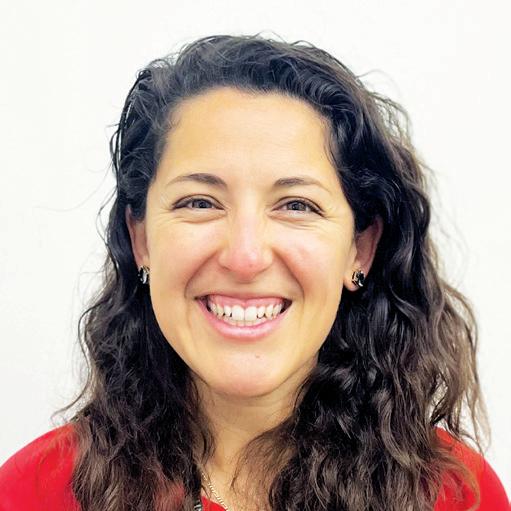
“My goal as the interim was to support the Office of Equity and Inclusion and the school as the year went on,” said Muñoz, who also teaches Upper School English. However, strong support from the community inspired Muñoz to pursue the director position.
Using her experience in education and facilitation, Muñoz says she intends to promote the key initiatives
established by the Office of Equity and Inclusion. This includes the ongoing integration of inclusion councils into school activities and harnessing these councils to address needs across the campus.
“There’s an appetite across the community for continuing to develop [equity and inclusion] at Greenhill,” said Muñoz. “The community is behind it, with many people believing in and wanting to be a part of this work and change. It was really heartening to me, and that is what ultimately made me want to apply to be the director.”
Three Middle School students won honors in the recently concluded 2024 National Chinese Speech Contest.
The three students are: fifth-grader Fiona Ou, seventh-grader Garrett Clark and seventh-grader Adam Tawil. They were among 1,000 contestants enrolled in Chinese language programs in 32 states.
The theme of this year’s competition was “The Beauty of Chinese.” Students wrote
a speech describing the beauty of Chinese in their personal experiences.
“I practiced every night,” said Tawil. “I mainly practiced not the words, but the inflection, the understanding of how to bring forth the speech so the meaning is clear.”
Middle School Chinese teacher Xiaoling Zhang says students must first brainstorm what they will write and then make a draft in English. Then they translate the draft into a simple and more comprehensible version in Chinese.
OAfter this, the students meet with Zhang to enhance their speech. Zhang says the students must be willing to put in a lot of work over many months.
The final round took place over Zoom, with competitors reading their speeches to a panel of judges. Afterward, the judges asked the students questions in Chinese.
This competition not only pushes students to be more hardworking and committed, but also teaches them the

importance of their Chinese studies. This competition is a great learning opportunity for students to develop a deeper understanding of the language, according to Zhang.
“The language is not only a subject – it is how you are able to use it,” said Zhang. “If you learn it you can use it. This competition shows that you are able to use Chinese in real life.”
n April 12, the campus buzzed with cultural enthusiasm during the annual Greenhill Goes Global event in the Cox and Phillips Gyms.
Susmita Chavala, the parent of two Greenhill students – a third grader and a seventh grader – volunteered to run the Canada booth this year. She described Greenhill Goes Global as a valuable part of the school experience.
“Since Greenhill is such a diverse
Families shared their cultural heritage in booths representing specific countries. Parents brought artifacts, posters and even bites of traditional food to educate and engage students and other parents.
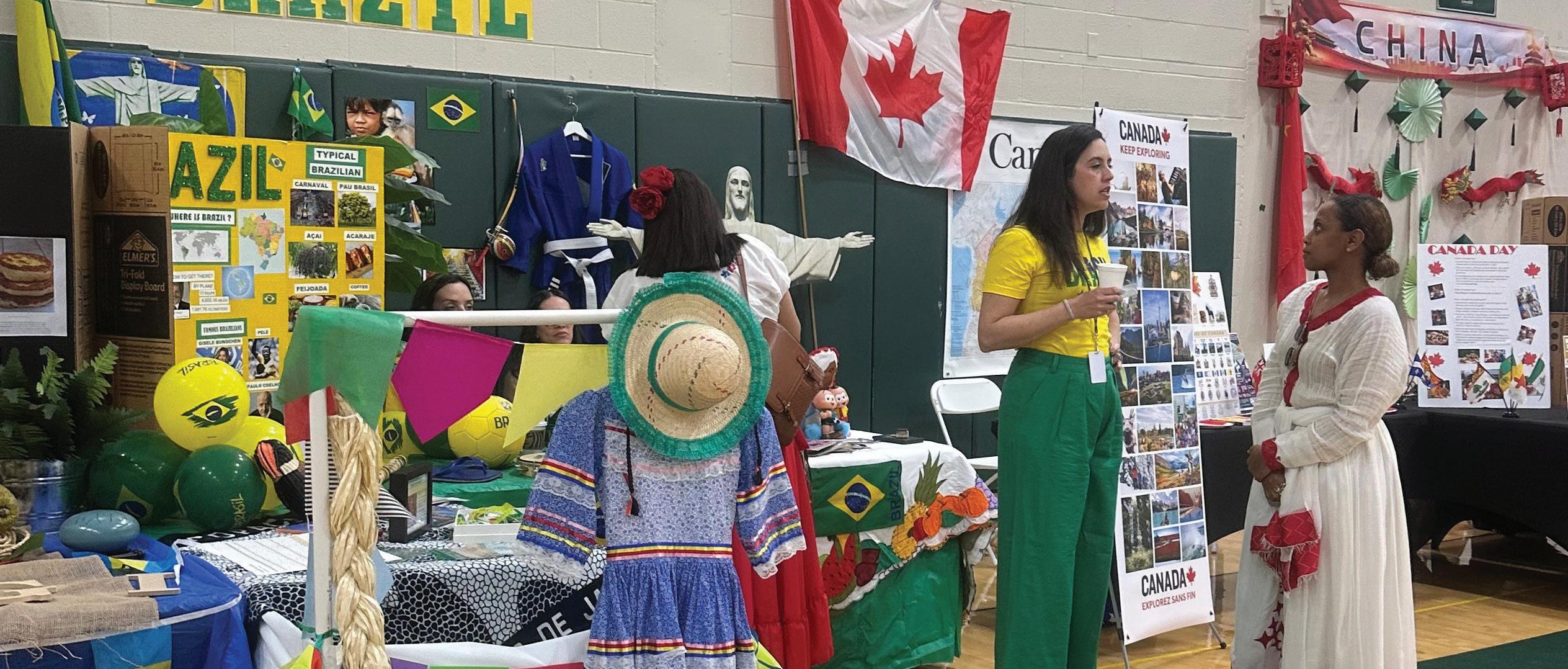
Eighth grade student Grace Helms marked the end of her Middle School Fine Arts journey by showcasing her work on May 7 in the Spring Fling, Middle School’s end-of-year arts festival.
Helms displayed her work in three areas, including a dance performance, an improv show, and a video production film.
“I think it went well,” Helms said after her improv performance. “I think the audience had a lot of fun.”
The event featured performances by students involved in band, strings, choir, improv, dance, and video production.
Fine Arts department faculty oversaw extensive preparations in the weeks that culminated with Spring Fling. Fine Arts Coordinator Maxey Goold worked with Upper and Middle School Band Director Brian Donnell to find space for all the different art groups.
They also both worked with SAGE Dining Services to ensure food was provided, and arranged for the printing of t-shirts that were distributed to students.
Preparation of the schedule for the various performances was complicated but paid off, according to Goold.
Students not only agree that the preparation was successful, but they even think that the hard work was well worth the time.
“The preparation work that the staff completed definitely paid off,” said seventhgrader Maahi Varma. “You can see the amount of effort put in by the organizers.”
Students also prepared for Spring Fling
to ensure their performances or films ran smoothly.
Band students began preparing their selections in early March. They were also expected to practice on their own time to ensure a successful performance.
“For the younger students, they have never done it, so there is a lot of anxiety and curiosity leading up to the show,” Donnell said. “However, older students are more experienced, so they are not as nervous.”
Even with the stress of performing, Spring Fling provides students with the platform to showcase their work, while setting the stage for future events.
In Upper School, students showcase their work at the Independent Schools Association of the Southwest Arts Festival. The festival takes place each spring, with an average of 30 schools participating.
Goold says that Spring Fling is both a platform to see different forms of arts and an inspiration for students to showcase their work at a higher level.
“Spring Fling is a great opportunity for students and families to celebrate the arts of middle school students much like ISAS,” Goold said. “It is an opportunity to be exposed to the different arts.”
This year’s Spring Fling succeeded in showcasing diverse talent from a wide range of grades and students.
“Spring Fling is one of the highlights of the year with lots of various talent,” said eighth-grader Sofia Williams, a choir student. “I’ll never forget performing with my friends.”
school, it’s so important to understand that we are all connected though we may have cultural differences,” Chavala said.
Greenhill Goes Global has become a campus tradition, according to Nina Verma, one of two chairs of this year’s event and the parent of a Greenhill fourth grader.
“It started nearly 20 years ago, and it has grown significantly,” Verma said. “Now, not only do we have parents hosting country booths in Cox Gym, but we also have student performances from across the world in Phillips Gym. Greenhill Goes Global is a true reflection of the diversity of our community.”
This growth reflects Greenhill’s growing diversity, with new country booths being represented each year, according to Verma.
The theme of this year’s event was “tradition.”
During the school day, Lower School classes previewed the event by visiting different country booths. Each booth was run by families or teachers with personal connections to the country.
Over 150 student performers, who had been practicing for two months, showcased
their cultural dances. Greenhill also hired two professional dance groups to add to the excitement.
To make the experience seem like an international journey, students were issued passports before entering the venues. Students could get a passport stamp at each booth after listening to a presentation about the country. A passport bearing a stamp from each booth earned a mystery prize.
One of the important takeaways of the event is that it allows students to embrace their culture.
“I can tell you that there are so many families that have never seen anything like this,” said Head of Preschool and Lower School Michael Simpson. “It makes them feel so included and like they belong.”
Afterward, students described the event as fun and educational.
“Overall, Greenhill Goes Global is an event where you can learn about different cultures in an exciting way,” said seventhgrader Daniella Antypas.
MS Evergreen students Jordan Arbuckle and Bailey Fisher contributed reporting to this article.
 Jordan Arbuckle, Bailey Fisher
Photo by Ella Sadka
GLOBETROTTING: Family, friends and faculty gathered for Greenhill Goes Global, which is an annual event that allows Greenhill families to share their cultures.
Aashi Punnam, Nithya Rao
Graphic by Christan Park
Chloe Nguyen
Jordan Arbuckle, Bailey Fisher
Photo by Ella Sadka
GLOBETROTTING: Family, friends and faculty gathered for Greenhill Goes Global, which is an annual event that allows Greenhill families to share their cultures.
Aashi Punnam, Nithya Rao
Graphic by Christan Park
Chloe Nguyen
5:45 A.M.
My alarm rings and I let it play for as long as possible. Eventually, I drag myself out of bed, shower and get dressed. As I prepare for the day ahead, I brew coffee and toast a sourdough English muffin for breakfast, which I can easily enjoy on my drive to school. Before heading out, I feed my four cats and give medication to my two foster kittens.
7:15 A.M.


Upon arriving at school, I touch base with [Upper School math teacher Kent] Thele and prepare for the day ahead. I then meet with a student who was absent for a week, helping her catch up on missed material and ensuring she’s prepared for class. Once that’s done, I

12:50 P.M.
I sit down with another student who has been absent for a few classes due to track meets, ensuring they are up to speed with their coursework. Afterward, I return to reading and responding to the roughly 40 emails I receive daily. Most of these messages pertain to educational technology and our transition to the new [STEM] building. 11:15 A.M.
To avoid the lunch line, I head to lunch a little earlier and spend some quality time catching up with colleagues.
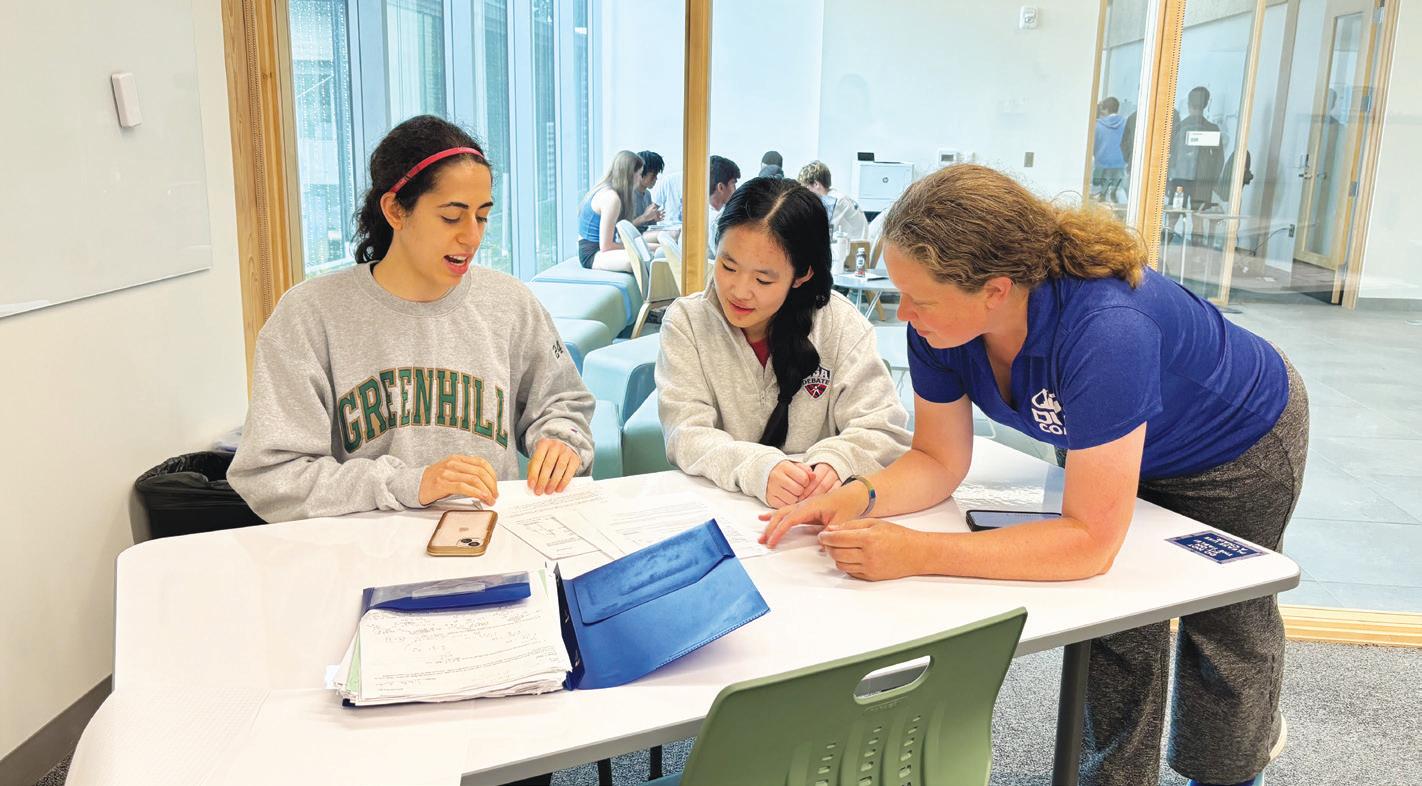
4:00 P.M.
1:50 P.M.
I open the Math Lab, offering support for various needs and matching tutors with students who require assistance in math. Once that’s done, I teach Honors PreCalculus. Today, we’re reviewing for an upcoming test with a fun game of Trashketball before diving into problem sets.
After gathering my lacrosse gear, I change clothes, catch up with colleagues and head to the fields to assist Coach Katie Zarembski with girls varsity lacrosse practice. I always appreciate spending time with the team and working with them outside the classroom. It’s refreshing to see the girls in a different setting, as it reveals new aspects of their personalities and skills.

10:00 P.M.
8:00 A.M.

5:05 A.M.
My alarm goes off, and I allow myself a 5-minute snooze to prepare for the busy day ahead. I start the day with yoga stretches to fully wake up, then shower, brew my espresso and enjoy some morning reading. Currently, I’m immersed in a Spanish novel set in 1980s New York, centered on a Jewish woman living with her mother, “Apegos Feroces” by Vivian Gornick.
I head to school and begin the day with a committee meeting before teaching my AP Spanish class. Later, I catch up on emails before a meeting with [Assistant Head of Upper School Rebecca] Shuman and [Upper School Registrar Darcy] Rosa. Together, we finalize the schedule and logistics for May 11, when placement tests for new families joining Greenhill are scheduled.
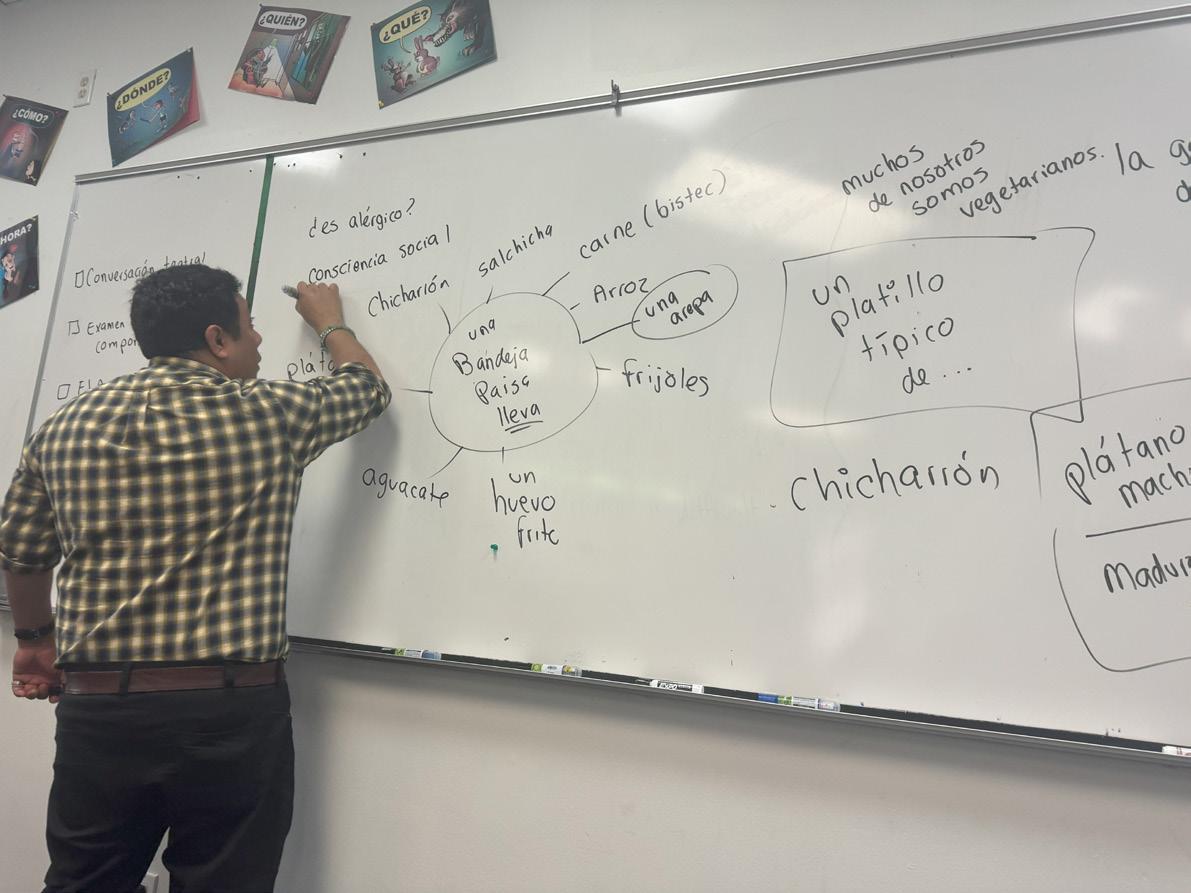
I meet with a student who will be absent from class, helping them get a head start on upcoming assignments. Afterward, I take a break to recharge. 11:00 A.M.
12:00 P.M.
I enjoy lunch with [Director of Service Learning & Community Engagement Jessica] Chu and occasionally [Director of Equity and Inclusion Monsie] Muñoz if she’s free. This time serves as a much-needed mental break where we chat about anything but school. Sometimes, I just need a break from work discussions. We share laughs and exchange recommendations for upcoming shows or concerts. It’s a refreshing and enjoyable pause in the day.


Once I’m home, I unwind by scrolling through Facebook and Instagram while catching an episode of NCIS. This allows me to relax for a good half-hour before I warm up dinner and eat. It’s a chance for my mind to rest and reset before diving back into creating tests, grading quizzes and answering emails. Occasionally, I’ll spend 10 minutes in my car listening to the radio to decompress before heading inside.
I head to bed and drift off around 10:30, often with the soothing backdrop of NCIS. This long-time favorite show of mine serves as a comforting end to my day.


Upper School math teacher Melissa Battis wears many hats. In addition to teaching math, she serves as an educational technologist and assistant girls lacrosse coach. Off campus, her responsibilities as a “cat mom” occupy a central place in her life.



4:00 P.M.
2:00 P.M.
I attend a Link Crew logistics meeting, collaborating with [Upper School Counselor Kathy] Roemer and [Upper School Spanish teacher Stephanie] Almanza to plan recruitment for the upcoming school year. After a short break, I meet with a college counselor to discuss specific students. Following that, I consult with the technology team to address an audio issue in the Lecture Hall, as we need to project a documentary for the class of 2027.
Since it’s a Tuesday, I’ll stay later at school for volleyball practice on Alpha Road. After a long day, I take a 15-minute walk to clear my mind. Then, I spend time catching up on grading, responding to emails and preparing for the week ahead.

10:00 P.M.
7:00 P.M.
Following a one-on-one Spanish tutoring session with a student, I head to my club volleyball practice. The two-hour session concludes at 9:30 p.m.
After showering, I spend time writing in my journal, a nightly ritual that helps me unwind. If my mind is busy, I focus on gratitude to alleviate any anxiety by jotting down my thoughts. This practice is a calming way to end the day, signaling to my body that it’s time to relax and prepare for sleep. While there will always be more to do tomorrow, for now, it’s time to rest. Occasionally, I enhance my journal entries with watercolor, a skill I picked up this year.


Upper School Spanish teacher Jacobo Luna juggles multiple roles. In addition to his classroom responsibilities, he serves as ninth grade dean. Off campus, he excels on the volleyball court as a setter.
Upper School Dean of Students
Jack Oros first came to Greenhill intending to be a math teacher. Little did he know that 35 years later his influence would have changed the lives of many students and faculty at the school.
Oros interviewed for the position of an Algebra II teacher in 1989. On campus, he quickly became acclimated to the way that students and teachers at Greenhill had relationships he had rarely seen at other educational institutions.
caused the dances to be not as enjoyable for the underclassmen, according to Oros.
“We started the random breathalyzer and in doing so, it changed the culture of the dances,” Oros said.
Others on campus, including Head of Upper School Trevor Worcester, have noticed his efforts to support the student body.

“[Oros] pays attention to that bigger swath [of students], and I think that’s important for a [dean of students] to have that kind of pulse on what’s happening,” Worcester said.

“It’s a special thing, and teachers that come here from some other places say it’s not like elsewhere,” Oros said. “Also, kids that come here from their other schools say they don’t get it for a while, until they eventually understand that the teachers are there for them.”
Now, Oros has decided that it is time for him to retire after 12 years as Upper School dean of students.
“When I retire, I’m going to miss having my hand in the middle of it all,” Oros said. “What am I going to do?”
Throughout his time as dean, Oros has implemented a variety of policies and traditions. He says he hopes many of these will be carried on once he leaves.
It’s a special thing, and teachers that come here from some other places say it’s not like elsewhere. Also, kids that come here from their other schools say they don’t get it for a while, until they eventually understand that the teachers are there for them.”
“Our goal is keeping kids safe,” Oros said. “Breathalyzing before school dances was my idea.”
Before this was a policy, students showed up to school dances inebriated. This
Oros has also made various old traditions into his own. One of those is Bagel Tuesdays.
“Through bagel days, he brightens everyone’s day and smiles at each student as he hands out the bagels,” said senior Brenna Norton, who is also one of 13 students in the Oros advisory.
When I retire, I’m going to miss having my hand in the middle of it all. What am I going to do?
Although the tradition was started by his predecessor, Oros began making bagel chips out of the leftover bagels. In an added Oros touch, the flavors range from pizza to chocolate chip.
“I don’t want to throw away old bagels, so I make chips out of them,” said Oros. “Those sell as popular or maybe even more than the bagels.”
For many students and faculty, Oros’ traditions and policies have become synonymous with campus life.
“Mr. Oros makes sure that our school environment is always a special place with his traditions and every rule and policy he has made has really helped us all grow,” sophomore Jackie Dishman said.
Throughout his time at Greenhill, Oros

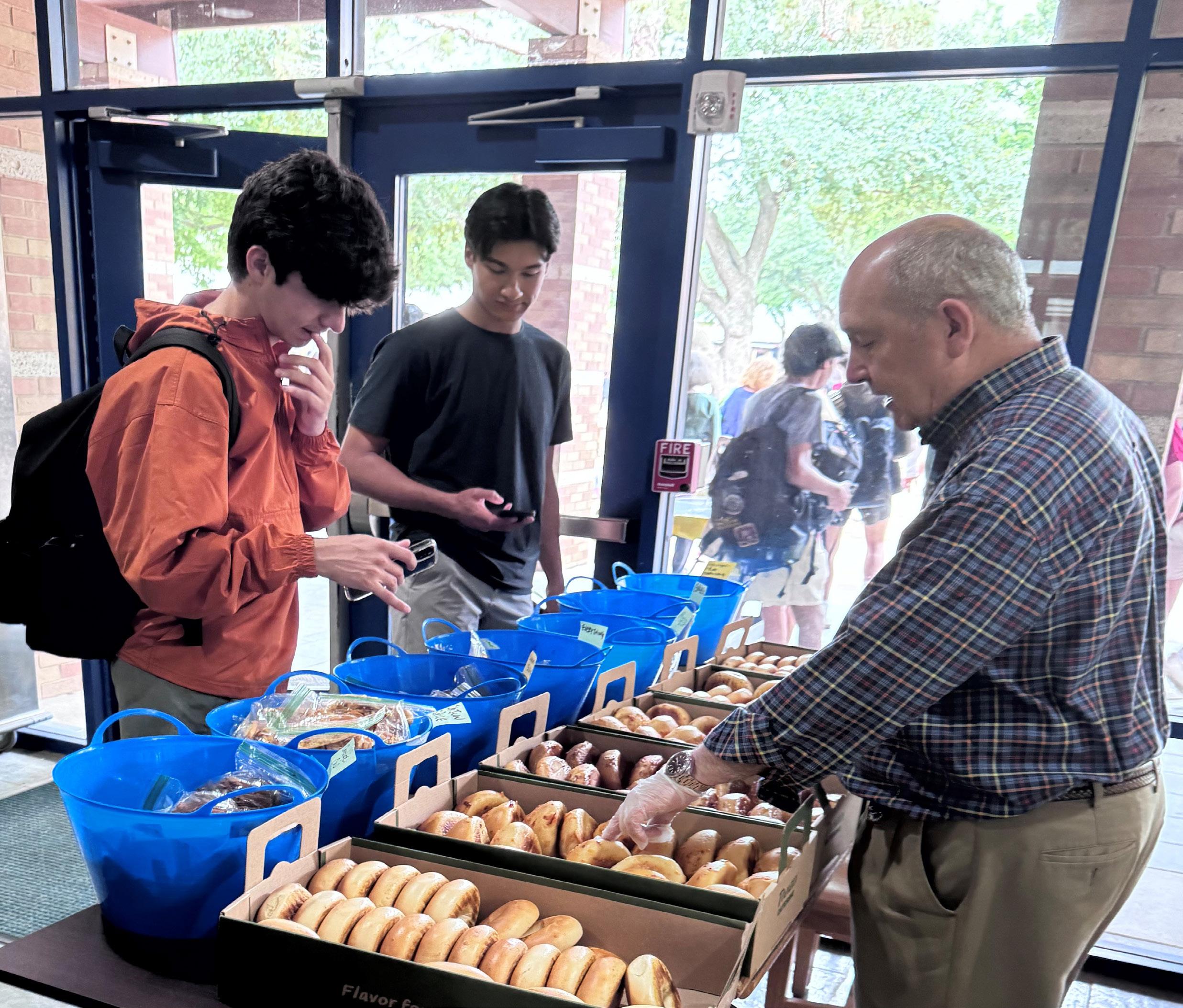
says he has collected many memories that he will cherish.
One of these from early in his time at Greenhill was a faculty chili cook-off.
“That was a fun experience because it was a time when all the faculty knew each other,” Oros said. “It was a much smaller team.”
[Oros] pays attention to that bigger swath [of students], and I think that’s important for a [dean of students] to have that kind of pulse on what’s happening.”
Another cherished experience was attending the Independent Schools Association of the Southwest Arts Festival almost every spring.
“I loved all the ISASes I went to and watching our kids perform and all the art being displayed and then getting to see all the other schools,” Oros said. “It’s a really special time and I wish more faculty could go.”
Oros has had an impact on student life as a math teacher and dean of students. Another area where Oros has made his mark is as a student advisor. He advised one student cohort that graduated in 2022, and another that is about to graduate.
Senior Max Kettles, who switched into the Oros advisory as a junior, cherishes this experience as well.
I loved all the ISASes I went to and watching our kids perform and all the art being displayed and then getting to see all the other schools. It’s a really special time and I wish more faculty could go.”
“The environment he fostered during advisory makes [students] excited for advisory each day,” Kettles wrote in an email.
Oros says he realized it was time for him to retire when he had to decide at the end of last year whether to take on another
cohort of students in an advisory capacity.
Now, after 35 years at Greenhill and 44 years in education, Oros says that he is “pretty tired but excited to see where the school goes.”
As Oros heads into his final days at Greenhill, he is filled with pride at what the school has become.
“I always say we put out a good product,” Oros said. “I’m very proud of the kids that are graduates and the people they become in the world.”
Already, community members are thinking about what will be lost with Oros’ departure.
Worcester says one of the things he will miss is Oros’ “institutional knowledge.” This vast knowledge of Greenhill’s past has helped Worcester navigate his years at Greenhill as a teacher and administrator.
“[Oros] deserves all the celebration and tribute you all are doing and everyone else is doing for him,” Worcester said.
In considering how to replace Oros, administrators decided his vast responsibilities needed to be shared across two positions.
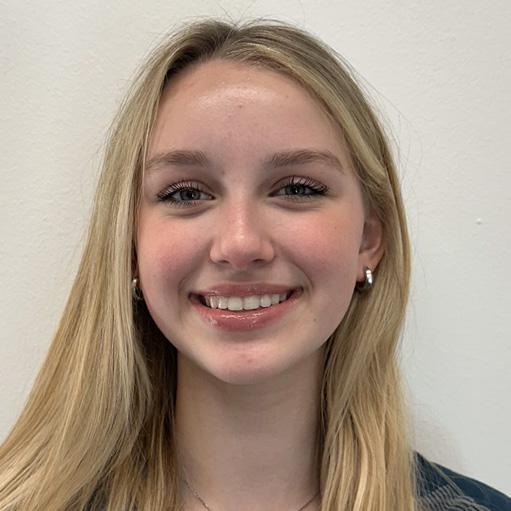
“I mean, the fact that we’ve split his job into two roles says a lot,” Worcester said.
Students say they are going to miss his smile in the hallway, or his drawer of candy that’s always open.
“Mr. Oros knows everyone’s name and always goes out of his way to make people feel welcome, which is something I’m really going to miss, especially in our senior year,” junior Ashley Weinstein said.
More than anything, Oros says he will miss his connection with his students, and he will miss watching their growth throughout high school.
“Greenhill kids are good kids deep in their heart,” Oros said. “Deep down inside, Greenhill kids are special kids.”
When senior Arjun Melwani was in Lower School, he visited the State Fair of Texas for the first time. While other students were entranced by the roller coasters and fried food, the only thing that stood out to him was the 3D printer.
“I thought it was the coolest thing,” Melwani said. “The fact that we could create objects out of thin air blew me away. From that point on, I [was] obsessed with 3D printing.”
There was only one problem: his parents wouldn’t let him buy a 3D printer. Despite this, he was determined. So, as a 10-year-old, he bought all the parts and built one himself.
Although nearly burning his house down in his first attempts to build the printer, his perseverance guided him to success. In time, Melwani started his own 3D printing business, Techabyte 3D.
“Orders were sparse at first, but very quickly my business began to expand,” Melwani said. “Companies with a digital design of a product would send me files to 3D print and I would simply ship a prototype back to them.”
“The fact that we could create objects out of thin air blew me away. From that point on, I [was] obsessed with 3D printing.”
In addition to selling mock-ups for companies, Melwani sold 3D-printed fidget spinners on the side, something that he describes as his “most lucrative business yet.”
“I learned so much through every customer interaction,” Melwani said. “But soon I realized I needed to find a more efficient business model, which is why I taught myself how to 3D design to help businesses create digital files and prototypes. That is when things really got going.”
As Melwani’s business expanded at an exponential rate, so did his customer base. With this growth came meetings with professionals.
“When there would be these meetings, I couldn’t just say I was a kid,” Melwani said. “So, I would tell my dad everything he had to say in the car, how to answer the common questions and he would lead the meeting, bringing me as the tag-along son.”
However, this strategy did not always
work. In one instance, Melwani said one of his customers had many technical questions for his father, who was unable to answer them.
“When my dad couldn’t answer, I just began speaking to the customer and he actually listened to me,” Melwani said. “That was when I realized I could actually present as myself in the professional industry, as long as I could prove myself.”
So, throughout his time in Middle School, Melwani kept building things –including a drone. And, as he began Upper School, COVID-19 hit, leaving him with more time than ever to build and create products.
Thinking about people at Trader Joe’s who had to touch the hand sanitizers in the store, putting them at risk of catching COVID-19, Melwani realized that he could create a more efficient solution.
“I built a simple add-on to retrofit hand sanitizer dispensers to make them automatic,” Melwani said. “My design received over 1,000 downloads. For the first time it made me feel like I was actually helping people. That is what really what got me into human-centric engineering.”
Realizing that he had finally found his true passion, the concept of human-centric engineering quickly became a cornerstone for all of Melwani’s projects.
“He is one of the most compassionate and selfless people that I have ever met,” senior Josie Arbuckle said. “He shows that through his passion and working on technology to make people’s lives better. He really wants to change the world and make it a better place.”
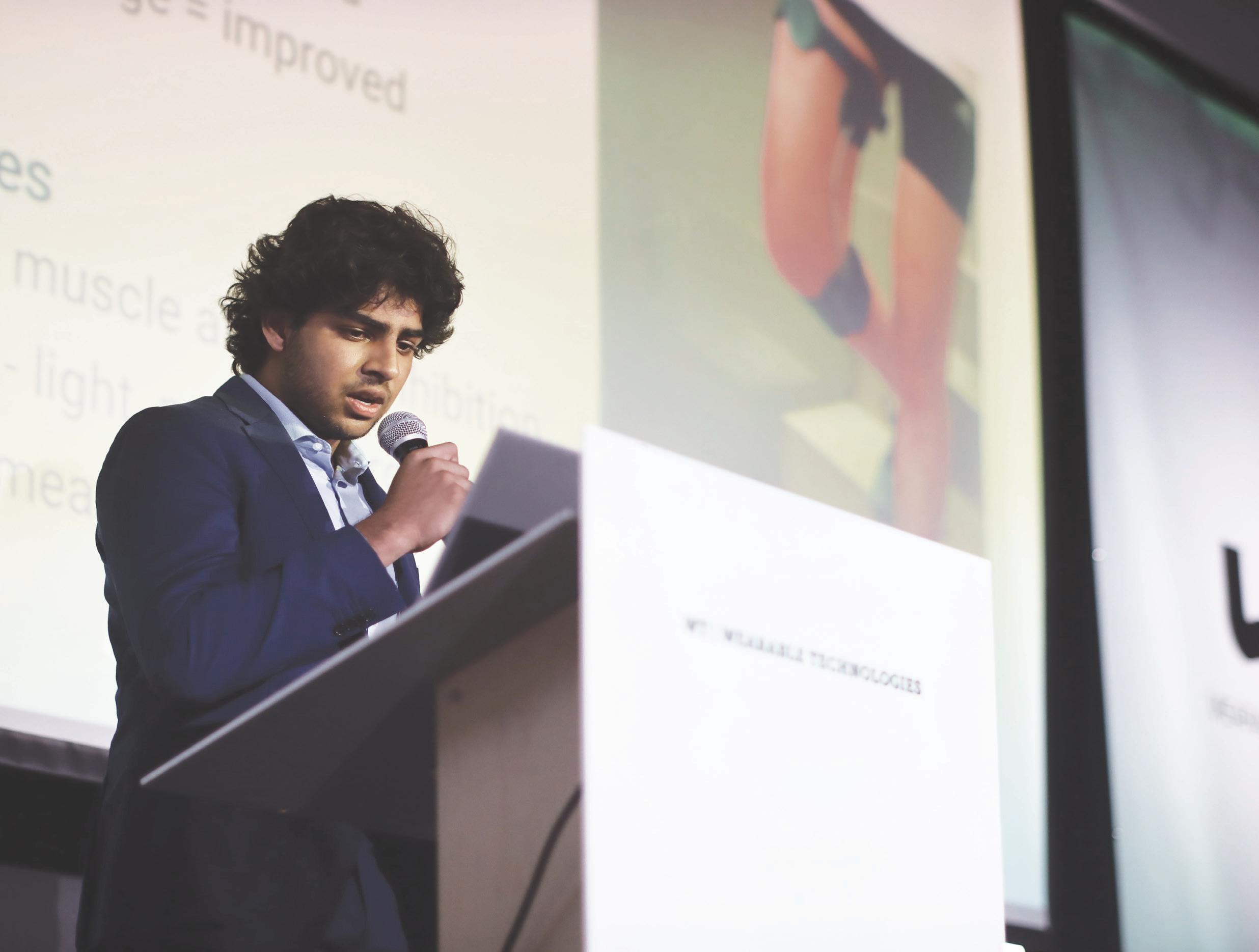
company’s mechanical design work.
“I think it is a testament to his tenacity, passion and grit,” said Director of Design and Innovation Matt Abbondanzio. “He just
at his lab.
“It was the first time I was surrounded by people who had the same drive for change and technology as me,” Melwani said.

will not let something go and he is willing to take risks.”
In the summer before his sophomore year, Melwani began to intern at a medical device startup called Articulate Labs, which focuses on human-centric engineering. At the company, he worked on a knee rehabilitation device that uses electrical stimulation and artificial intelligence to integrate physical therapy into daily activities.
While the company was initially hesitant to hire him, that changed after Melwani offered to do all their 3D design work in exchange for engineering mentorship.
Melwani says that by the end of his second week, he had taken over all the

By the end of his sophomore year, having taken most of the design and innovation classes offered at Greenhill, Melwani approached Abbondanzio about starting a tutorial research project for this junior year.
“He started talking about really heavy technical work so quickly,” Abbondanzio said. “I was like ‘wow, you are not supposed to know how to do that, right?’ I was like, ‘who is this kid?’”
Melwani started his independent study by completing market research and analysis to determine where biomedical engineering needs could be met. After narrowing his ideas to a few possibilities, he attended a disability technology conference where he was able to hear stories from those suffering from urinary incontinence.
“I was blown away by the difficulties they faced with so few solutions, so I wanted to begin research,” Melwani said. “I felt as if I had an obligation to help them.”
Throughout his junior year, Melwani spent much of his time teaching himself engineering, acoustics and computer science to develop algorithms to find a solution to bladder incontinence.
“I toggled between YouTube, [Upper School science teacher Nicholas] Park, Mr. Abbondanzio and my mentor at Articulate Labs to learn the engineering concepts needed for my project,” Melwani said.
Following his success there, he had the opportunity to pitch his research as a startup company to the Praxis Spinal Cord Institute, where he was a finalist for a $35,000 grant.
“What is so great about Arjun is that he is so intelligent and has done a lot of things some kids in college doing electrical engineering wouldn’t have done yet,” Abbondanzio said. “But he is also open and wants advice and is willing to listen and learn.”
Despite his dedication and work ethic, Melwani says he sometimes struggled to manage his busy schedule of work, school and research throughout his time at Greenhill.
“It was a challenge,” he said. “Admittedly, I was not getting much sleep and my daily routine was going straight from school to the lab until 10 and then doing homework after that. I was close to being burnt out.”
However, Melwani pushed through.
“It was really strenuous, but I enjoyed my research and the classes I was taking at school,” Melwani said. “So, as tiring as the hours were, I was loving it.”

After months of research and testing, Melwani was able to develop a sensor that could determine when the bladder is full. He also developed a way to stimulate the bladder to benefit those who are incontinent.
Melwani’s work attracted the attention of Dr. Joseph Paradiso at the Massachusetts Institute of Technology’s Media Lab. Paradiso invited him to present his research
Despite his demanding commitments, Melwani always found ways to support his friends.
“Even with all that he has going on, he always makes time for me and our friends,” Arbuckle said. “He has always shown up for me and supported me throughout high school.”
With his time at Greenhill coming to an end, Melwani is getting ready to attend college at MIT, where he hopes to further his passion for human-centric engineering.
“It has been really enjoyable to take some time my senior year to slow down,” Melwani said. “But honestly, I really want to get back to solving a really cool problem and giving back to the world. I love to build things and take things apart and learn about new things. That is what I want to do.”


The Greenhill Theater Department brought audience members into a world of Deep South accents, WildWest inspired costumes and a set that mirrored old Hollywood Westerns in their April production of “Much Ado about Nothing.”
For nine seniors who were actors and members of the crew, the play marked the end of their Greenhill theater careers.
“I think it was really bittersweet because it is hard to say goodbye to this program that has given me so much,” senior Quinn Graves, who played a lead role, said. “I am really grateful for all the experiences and memories I have made in Greenhill theater.”
The play followed the main storyline as the original Shakespeare production. The Greenhill production, however, was set in West Texas during the late 1800s.
“It’s been a long few months of dialect coaching, making sure we get the scenes to flow, and getting the ‘westerness’ vibe of the show,” said freshman Sidrah Tarpeh.
To immerse audiences in the show, chairs were set around three-fourths of the stage.
“They had us sitting almost inside, wrapping around the actual play, so it felt like you were in it, like you were a part of [the show],” Campus Store Assistant Manager
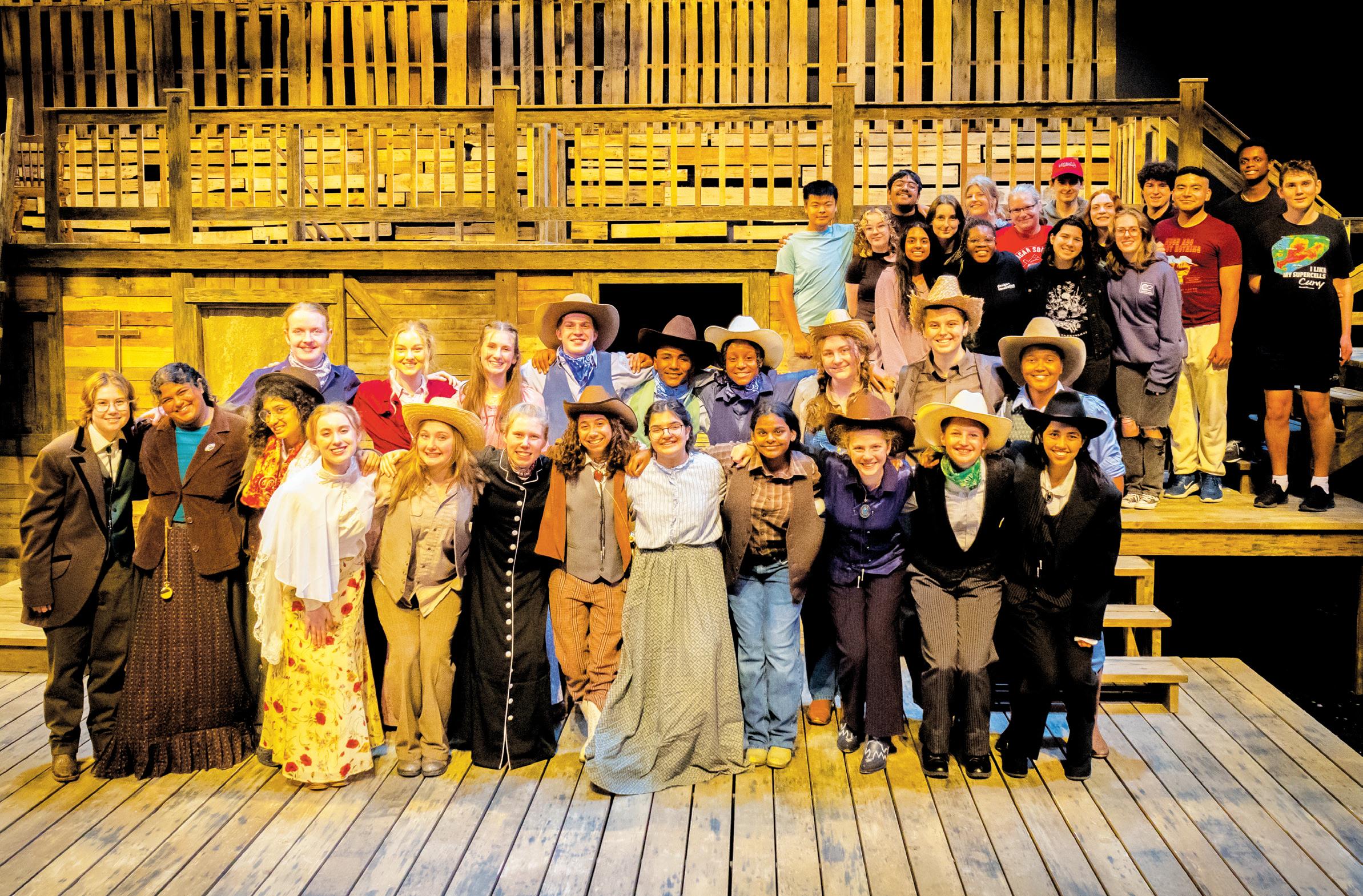
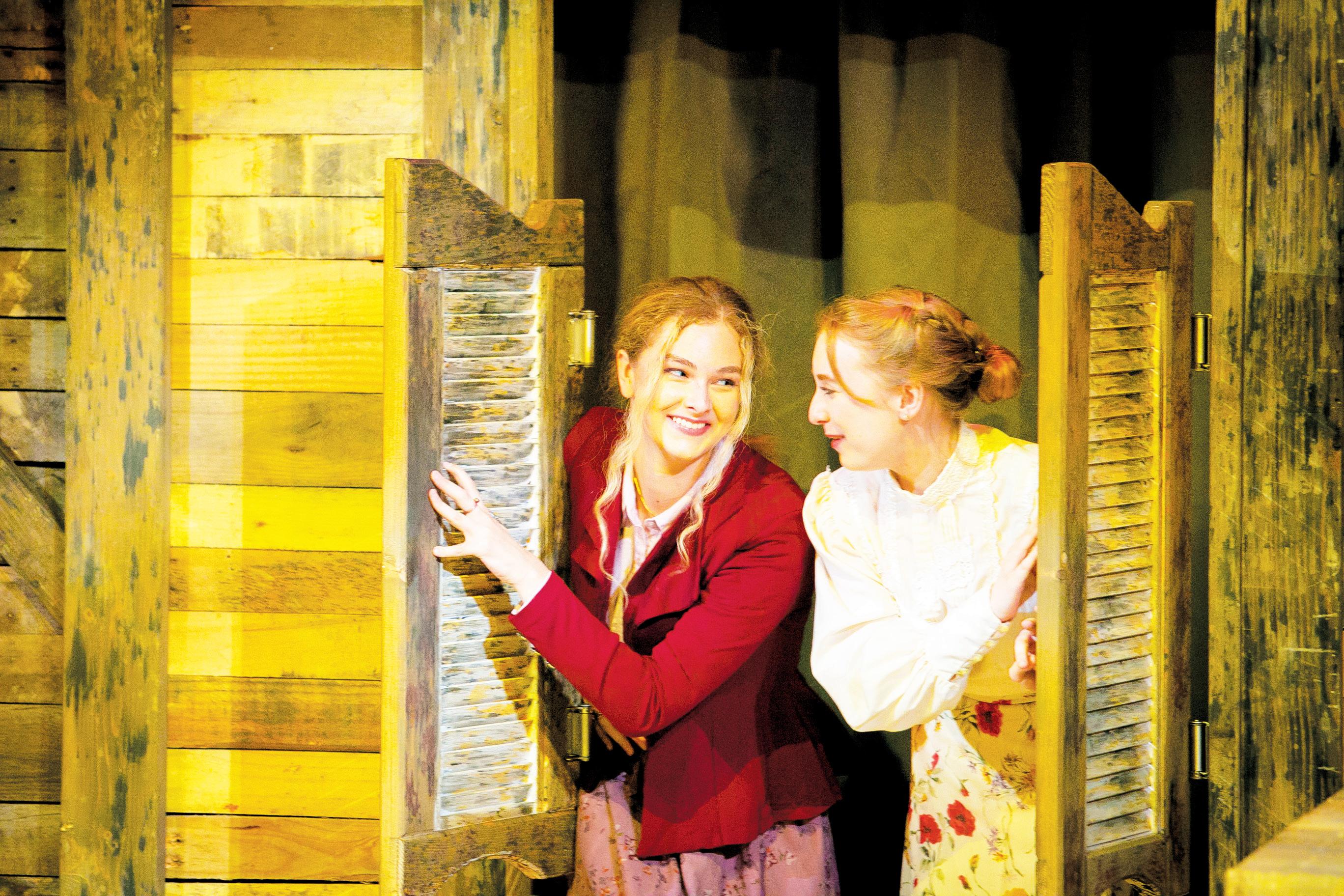 Photos courtesy of Greenhill Communications
Photos courtesy of Greenhill Communications

Andrea Stoyle said.
Two weeks before opening night, the cast and crew of “Much Ado about Nothing” had the opportunity to perform an excerpt of their show at the Independent Schools Association of the Southwest Arts Festival.
“[At ISAS], we didn't know the space,” said Upper School Drama instructor and Theater Director Valerie Hauss-Smith. “We were told we had a specific size of room to [perform] in, so our blocking had to be completely changed. It took us about a week to get ready.”
Although the festival halted preparation for the full production, sophomore Sumedha Rapuri said the ISAS performance helped her practice her acting part for the real show.
“I was able to get a taste of how the audience would react to our scenes.” Rapuri said. “So then from there, we were actually able to change things and make them funnier, make jokes more on point.”
Following ISAS, the cast and crew participated in strenuous after-school rehearsals. This period – dubbed “Tech Week” – is the time where the technical theater crew, actors and directors all work together to rehearse the full production.
“I think everyone in the play was working really, really hard,” sophomore Natalie Johnson said. “It's really hard to be in the late end of the year when teachers [are] piling up assignments. Getting home at 10 every day for a whole week is really hard, but I think they pulled through and made something really good.”
Upper and Middle School Technical
Theater teacher Will Turbyne said his students worked on the set for weeks.
“There's a lot of rough barnwood that the actors come into contact with,” Turbyne said. “The wood is smooth, safe wood, but we've painted it to look very rough and kind of rustic and old.”
To many audience members, the set enhanced the show.
“It was so good and way better than I could have imagined,” sophomore Nina Kaplinsky said. “The set and costumes came as a pleasant surprise; they were so elaborate and beautiful, it really put you into Messina, Texas.”
Since the play was held in the Studio Theater instead of Rose Hall, seating was limited. Because of this, the shows sold out quickly, forcing Hauss-Smith to set aside “no-show tickets.” If an audience member did not show up 10 minutes before the show, their tickets would be released to the public.
“The show was sold out and we were very nervous about whether more people than we could seat would show up hoping for no-show tickets, but every night we were able to seat everybody that came, so we were very happy about that,” Hauss-Smith said.
Those who had the opportunity to attend the show expressed positive reviews.
"I thought it was really good,” said freshman Brielle Kommer. “The actors were amazing.”
Sophomore Aydin Khan echoed this sentiment.
“I loved getting to see some of my friends perform in their element and be able to showcase the efforts they’d been working on for the entire semester,” Khan said.
The cast and crew of the play had positive experiences as well. They described how the months they spent with each other working on the play created a “family” environment and lifelong friendships.
“I love the cast; I love the people who do theater,” sophomore Ella Costabile, who also played a lead acting role, said. “They have been some of my biggest mentors and friends.”
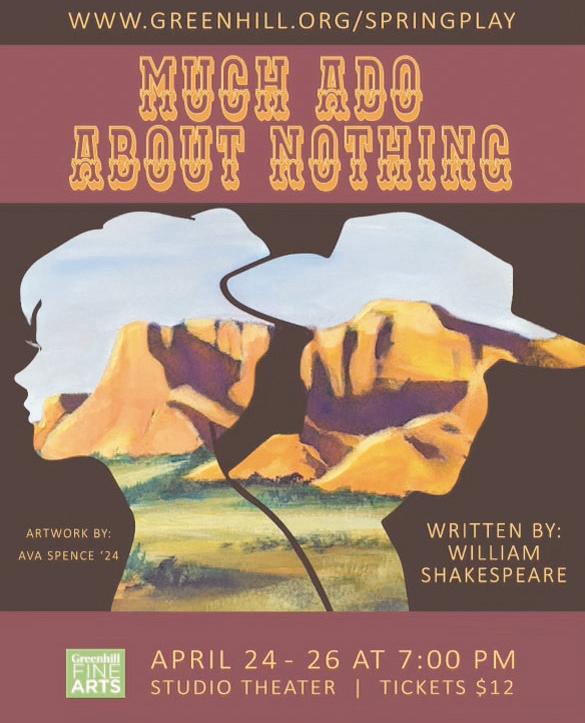
Over the past year, students in the Upper School’s Advanced Video Production class have produced a large number of works that have been accepted into film festivals on the regional and international level.
These festivals allow students to gain recognition for their films.
“I want them to put [their films] in the world because I don’t want to make these in a vacuum,” said Upper School Video Production instructor Corbin Doyle.
Doyle first began introducing the work of his students to the outside world by entering their films in the Dallas International Film Festival. Now, with Doyle’s encouragement, students enter their work in a wide range of competitions.
“Mr. Doyle was one of the big proponents that high schoolers should be able to submit to film festivals, which is typically reserved for college or post-college,” senior Pearce Barnes said.
Students use FilmFreeway, a website where they can submit their work to festivals around the globe.
For students in AVP, film festivals mean different things depending on the filmmaker.
Sophomore Ruby Garza says the acceptance of her film “Bagged A Good One” to the German film festival QUEERStreifen made her appreciate the class even more.
“I think it feels more real to me, because I’ve always

loved film,” said Garza. “I’m in this room with so many amazing, talented people and tons of resources, and I get to do something that I love so much for a class credit.”
Sophomore Syrus Gupta says he found the experience rewarding, especially because this was his first time to enter his work in a competition.

“It means a lot more than just ‘okay, I got my film in [this festival],’” said Gupta. “Now I get to have this opportunity to be part of a wider community and build connections with people who share those same passions and want those same things as I do.”
Barnes says he felt pride in creating his film “Crazy for Layne’s.”
“I did most of the things aside from just general hands-on set, which was really stressful and difficult,” said Barnes. “With that said, when you get to that final product, it’s something that you’re extra proud of.”
Barnes’ film got accepted into the Alternative Film Festival, an event that gives filmmakers the opportunity to qualify for Internet Movie Database-approved awards.
Juniors Andrew Cai and Ali Agha got their film “Hawkshaw Swing: Caravan of Dreams” into three events: the BAM! Festival, Youth Diversity Film Festival and Dallas International Film Festival’s 2024 High School Short Film Showcase. Cai says although the acceptances provide him with a sense of accomplishment, the audience’s reaction is the most rewarding.
Doyle compared the current program’s success to times before the COVID-19 pandemic. Although the number of films accepted to festivals was higher back then, the program is starting to recover, Doyle said.
“Part of [the program’s recovery] is me reeducating AVP,” said Doyle. “I change my classes from semester to

“When you play your film, you can see when your audience laughs, or when they cringe,” said Cai. “There’s a hum in the atmosphere where you can just tell whether they like something or they don’t.”
OBarnes also says that he feels the program moved away from film festivals and more toward personal and school success.
“I think the drive towards [film festivals] dwindled a little bit,” said Barnes. “Now I think we’re finding a balance where we can make films for ourselves and still show them at festivals while satisfying yourself and not working for some name only.”
For the upcoming year, Doyle says his intent is to redesign the program in the hope of keeping the environment livelier and
“I have to restructure it so that rather than from month to month that I’m holding them accountable, now it’s day to day,” said Doyle.
The bottom line for Doyle is that he wants students to use the knowledge they gain in class to make films.
“I want it to be about process more than product,” said Doyle. “I think if we concentrate on the process, rewrite and reedit and have fun making these things, get better at the process, then these film festival things will happen.”
n May 16, the Upper School Orchestra and members of the Upper School Band will perform at the class of 2024 Baccalaureate ceremony at Temple Emanu-El in Dallas.
Although the Upper School Orchestra opens and closes the ceremony with the prelude and procession music, respectively, there will also be a chamber group performance that includes the graduating seniors.
“In recent years, more often than not, we have had a group of seniors that have come together to play a special musical presentation during the service,” Upper School Orchestra teacher Nick Paraskevas said. “This is one of the ways where it’s a little bit more like a service because you have readings, and they alternate it with music.”
This year, seniors Reyna Diamond, Jadon Lee and Alex Wetzler, juniors Sherry Zhang and Varun Mukund, and sophomores Myra Puri, Aaron Kuang, Shriya Nadagouda and Yichen Shi will perform “Bohemian Rhapsody” by Queen. This differs from the typical classical pieces that are played at Baccalaureate.
“I’m so happy to play at Baccalaureate again, and performing a pop piece is especially fun since I haven’t had an experience like that in orchestra yet,” said Zhang.
For the Band, a woodwind quintet comprised of senior Ayne Park, juniors Christan Park and Aditi Vikram, sophomore Sanay Nesargi and freshman Carys Diamond will perform “Rondo Alla Turca,” also known as the “Turkish March,” by Wolfgang Amadeus Mozart.
“We performed this piece at [Texas Private School Music Educators Association] Solo and Ensemble, and I’m excited to perform it again for Baccalaureate,” Vikram said.
Since the Orchestra performs several concerts throughout the year, Paraskevas says the aim is to combine all the repertoire to make a worthy Baccalaureate program for the senior farewell.
“We typically have two concepts to draw from: the concert that we performed at the [Independent Schools
Association of the Southwest Arts Festival] and the concert in early May,” Paraskevas said. “Plus, some of the kids work on chamber music, so we don’t have any difficulties finding 30 minutes worth of good music to play.”
“Bohemian Rhapsody,” on the other hand, was chosen by the three seniors in Orchestra, and will be performed for the first time at Baccalaureate. The seniors chose this song because they say it was a cool sounding song and they wanted to pick something that was different from the norm.

“Since we usually play classical pieces that most people don’t know or can’t recognize, we wanted to choose a song that people would know the melody to,” Lee said. “It’s also just a really fun song to play and perform.”
Other members of the chamber group say this piece is a good way to showcase the seniors’ ability and highlight their performance.
“I think playing ‘Bohemian Rhapsody’ provides a nice contrast to the normal pieces that we play,” Shi said. “We have given the dominant melody parts to the senior violas
and let them take leadership and ownership in their last performance with Greenhill Orchestra.”
Similar to the chamber orchestra group, the woodwind quintet will perform “Rondo Alla Turca” for the first time in concert on May 16.
“Since we usually play classical pieces that most people don’t know or can’t recognize, we wanted to choose a song that people would know the melody to. It’s also just a really fun song to play and perform.”
“We’ve been practicing for our performance every day in band class, and we feel very prepared,” Vikram said. “I’m honored to be able to play for all of the seniors and their families at Baccalaureate.”
Ayne Park, who is the only senior Band member that is performing at Baccalaureate, says that having a meaningful send-off is important to give her closure in an elective she’s participated in for so many years.
“It’ll be really nice to play at the end of year with everyone present,” Park said. “I think it’s more meaningful because I remember I did a lot of performances in front of everyone in Middle School, and this final performance will show my growth after all those years.”
Similar to Park, many of these seniors have been playing in the Band or Orchestra since Middle School. Paraskevas has worked with some of the graduating seniors for up to eight years, and because of this, he says that Baccalaureate holds a special place in his heart.
“When we finish playing the pre-Baccalaureate music and our seniors set their instruments down, they find their places among their classmates in the processional line of seniors being celebrated,” Paraskevas said. “It is an emotional moment for me, I will admit. It’s the last time we will have played together as the Greenhill Orchestra.”
Upper School students attended the Independent Schools Association of the Southwest Arts Festival in Austin from April 11-13. The Evergreen asked students who attended about their experiences.


“I thought that the critique went really well. [The critic] was extremely insightful, and it was evident that she always attempted to understand the artist’s piece. At the end of each artist’s critique, she provided helpful, constructive feedback about how we could be more intentional and further ideas for our artist statements. ”
– senior Mason Chow

“ISAS was so fun, and my favorite parts were playing kickball and watching different performances. I also really liked the silent disco with my friends.”
– senior Zoe Dzialowski

“My favorite part of ISAS was going to the rock concerts because we were able to see other schools perform, and I liked being able to experience a different type of art that we aren’t normally exposed to.”
– senior Elizabeth Mann

“I loved getting to go to many of the ISAS coffeehouses because you got to experience and see talent from people from different schools. It offered a great environment to appreciate different people’s musical talents as well.”
– junior Brynn Zawadzki
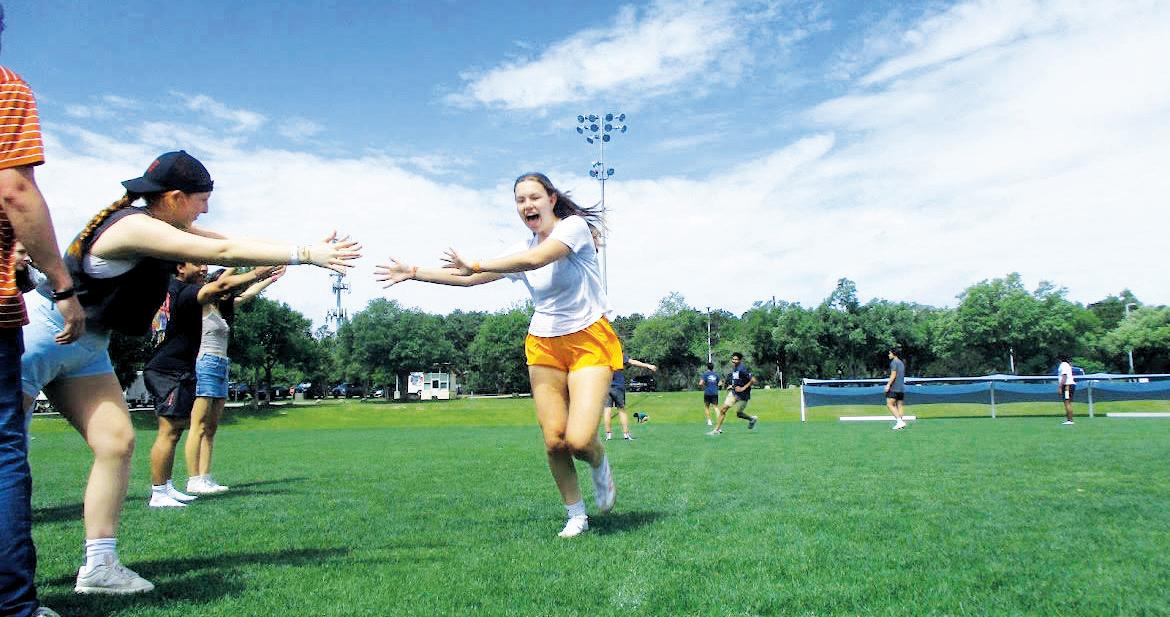


“The improv show was such a good example of how people can be so creative in different ways. A lot of people that performed in the improv show also performed in many other things at ISAS and that was cool to see. I liked the improv show at ISAS because it was super engaging.”
– junior Fancy Gonzales
Scrolling through short videos on Generation Z’s beloved social media platform, TikTok, is a large part of daily life for many Greenhill students. In the lunch line or during breaks in the day, some students are on TikTok frequently.
The thought of life without TikTok is unthinkable to some students, but Congress has voted to ban the app because of national security concerns due to Chinese ownership of its parent company, ByteDance.
On April 20, the U.S. House of Representatives voted 352-65 in support of legislation that would ban TikTok in the United States. On April 23, the Senate followed suit, and President Joe Biden signed into law the act known as Protecting Americans from Foreign Adversary Controlled Applications.
Now, ByteDance has nine months to sell TikTok to an American buyer. The president can extend the Jan. 24, 2025, deadline by 90 days if a deal is in the works by the end of the period.
The law provides for the complete ban of TikTok in the U.S., and it would allow the government to take action against app stores and impose fines and other accountability mechanisms on ByteDance if they continue distributing TikTok in the U.S.
Many Greenhill students and teachers say they feel conflicted by the possibility of a TikTok ban.
“I agree that it definitely could be a privacy concern if China is able to access individuals’ data, but at the same time, I don’t think that banning TikTok would do anything to change that since there are so many other apps that are collecting your data,” said junior Aditi Vikram.
The U.S. has the largest TikTok consumer base in the world, with over 150 million users, almost 20% of whom are under 17.
Government officials are apprehensive about the potential for the app to potentially compromise sensitive user data and leak it to the Chinese government. This apprehension stems from Chinese legislation that enables China’s Communist Party-controlled government to covertly acquire data from both Chinese corporations and individuals for intelligence purposes.
U.S. Sen. Mark Warner, a Virginia Democrat, said in an interview with NPR that “the problem is that TikTok has no option other to respond to the needs of the Communist Party of China. That takes primacy over return to shareholders or to customers.”
There are three main concerns that U.S. officials hope to address with a TikTok ban.
First, officials believe that TikTok’s potent algorithm could be used by the Chinese government to inject disinformation into American political races. Second, politicians fear the Chinese government might collect the personal data of U.S. citizens who use the app. Third, many worry that the Chinese government may download dangerous software onto devices across the nation.
The U.S. is not the first country to harbor these concerns. India banned TikTok and hundreds of other Chinese-owned apps in 2020, citing national security threats. The United Kingdom, Canada, France and Taiwan have banned TikTok for similar reasons.
The Treasury Board of Canada Secretariat describes TikTok as “presenting an unacceptable level of risk to privacy and
security.”
Attempts at banning TikTok in the U.S. have been made before. Former President Donald Trump attempted to use his emergency powers to block the app in 2020 and President Biden banned the app on federal devices in 2023.
Furthermore, several universities, including the University of Texas at Austin, Texas A&M University and the University of Florida, have banned TikTok on their campuses by blocking it on their university Wi-Fi networks.
With a large portion of the Greenhill student body using TikTok, the potential ban of the app has raised both campuswide alarm and support for a crackdown.
Many question how such a ban would be enforced. In countries such as China, internet access is regulated by the government. However, in the U.S., there is no such restriction.
“I think they were talking about removing it from the app store so anyone who wants to download it in the future wouldn’t be able to download it,” said Upper School History Department Chair Amy Bresie. “However, so far as I know, there is no way of deleting TikTok from every phone that already has it.”
Many students and teachers also question the bill’s constitutionality. Without any public evidence of China’s exploitation of TikTok, many argue that the federal government is restricting the First Amendment rights of speech and expression. This is especially true considering Congress’ attempts to force a sale of TikTok to an American company.
“There’s definitely concerns as to whether banning TikTok would be violating people’s free speech,” said Vikram. “The bill would have to provide a clear and present danger in order for the government to shut down a source of media for the people.”
For this same reason, Bresie says she disagrees with the ban, despite having unfavorable views of the app.
“I think TikTok is dumb,” said Bresie. “But I also believe in free speech, and I think it would be sort of absurd to have the government come in and as a whole ban TikTok.”
As the ban looms, many have questioned the political intentions behind the effort. Many politicians who have used TikTok as a campaign platform also support the legislation, prompting charges of hypocrisy.
losing Nationalist forces in the civil war won by Mao Zedong’s Communist soldiers in 1949. China contends that Taiwan is part of its sovereign territory, while Taiwan effectively functions as an independent country on the strength of U.S. military and diplomatic support.
With the recent aid package passed in Congress for Taiwan as well as Ukraine and Israel, U.S. relations with China are strained.

Sophomore Trent Hedrick views the ban as a way for politicians to further a foreign policy agenda against China.
“I think that they’re using China as a fear-mongering tactic,” said Hedrick. “And I think that’s something that’s been present in American politics for a long time.”
One of the irritants in U.S.-China relations is U.S. support of Taiwan, the island-nation that became the refuge of the
“I think it’s definitely a PR thing,” said Hedrick. “I think a lot of representatives [in] Congress think that it would be beneficial for their campaigns to push out TikTok since it is disliked by their older constituents.”
Many students and faculty members
also agree that a potential ban could be harmful to small businesses in America because they rely on the app for advertising.
TikTok recently reported that the app was responsible for generating roughly $15 billion in 2023 revenue for 7 million small American businesses.
“I think a lot of individuals are angry, especially now, because
“It is very clear that Russian propaganda influenced the 2016 election,” said Bresie. “So far, reports have indicated that both Russia and China are engaging in misinformation campaigns to sway this upcoming presidential election.”
At the same time, students and teachers say the ban fails to confront the core issue of social media transmitting misinformation and radical ideas.
“I do think most social media has misinformation, not just from China, from all over the world,” said Upper School counselor Kathy Roemer.
But is the solution a ban on TikTok?
Junior Madi McClellan said she would just switch to another social media platform with the same concept as TikTok’s shortform videos if a ban were to take place.
“I think that if TikTok was banned, it would obviously leave a vacuum for another entertainment platform to get more popular,” said McClellan. “So, I think I would probably just go back to using Instagram Reels or whatever I used before TikTok.”
they found out about something because of a TikTok and then went and dug in and got more information and I think that’s awesome,” said Bresie. “One way that I see students use TikTok is finding news stories and figuring out what’s happening in the world and educating themselves on different things.”
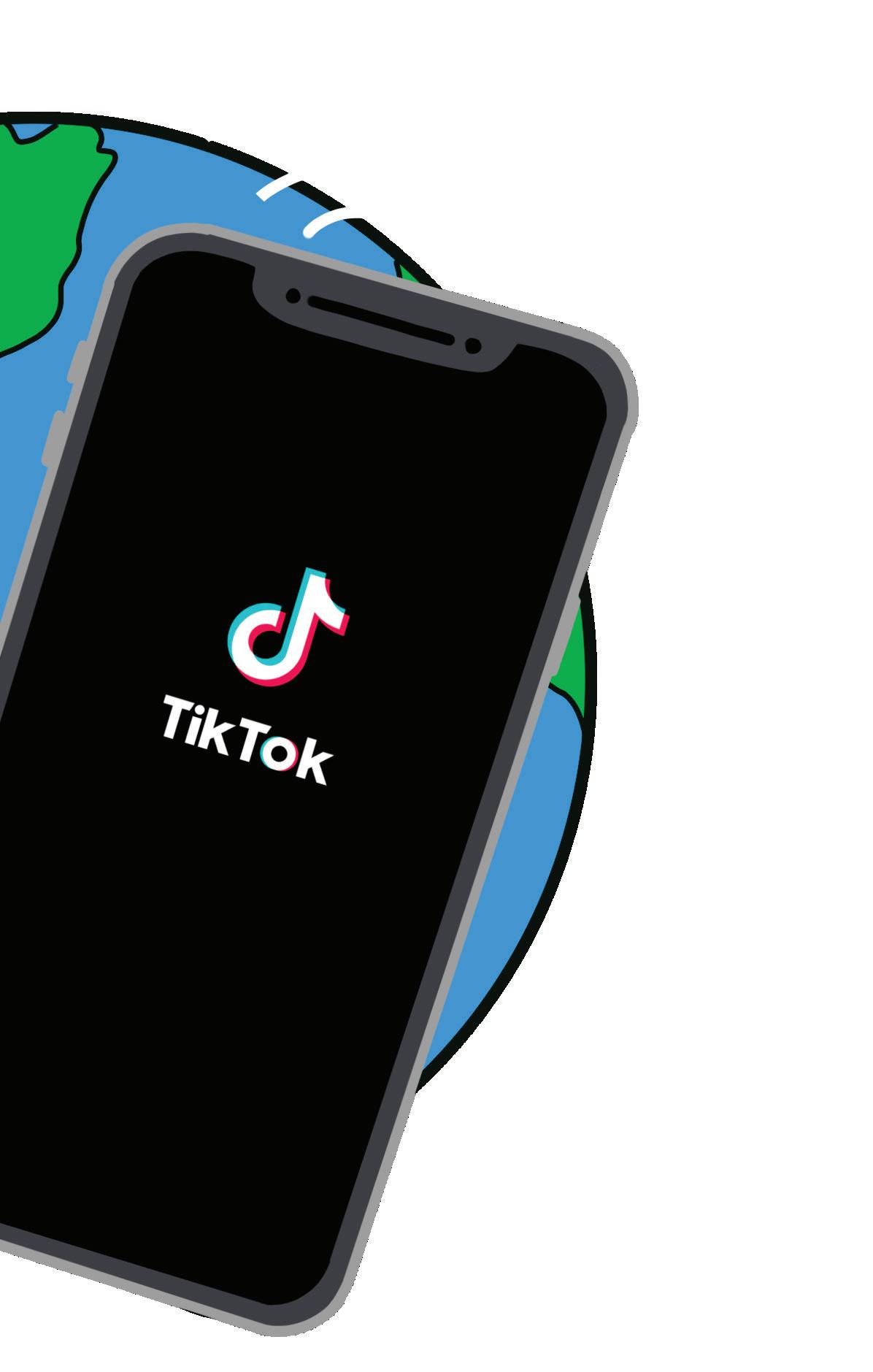
there are people who rely on TikTok for their jobs, and there are people who rely on TikTok for advertising,” said Vikram.
Despite concerns about the intentions behind the ban, students and teachers understand the core reasoning behind the legislation.
A primary concern of some Americans is the potential of TikTok to influence U.S. elections.
Though a potential ban of TikTok is unlikely to curb social media usage, the constant chatter surrounding the app’s future has sparked discussion on how students are using the app and other social media platforms.
Many believe that TikTok is not all bad. In fact, some believe that the app can be quite informative.
“I do notice that students tell me that
Head of Upper School Trevor Worcester says getting information from only one source is the perfect recipe for creating echo chambers.
“If TikTok is your only source of ‘news,’ I’m a little concerned about that,” Worcester said. “I would say it’s not just TikTok, it’s I think anything where you are saying: this is my sole source of information. The silo effect that can happen regardless of your ideology, and that’s just troubling.”
Because of the way that the TikTok algorithm works, viewers are often shown videos on their feed that match the kinds of content they interact most with. If someone only interacts with content on one side of the political spectrum, in theory, they will continuously be shown content that reiterates those ideals.
Upper School history teacher Scott Cotton says it is important to teach students to mitigate the risks of misinformation on social media.
“I think that in the government class, maybe [social media] should be a unit,” said Cotton. “Overall, maybe we as a school should look at this more carefully. We try to eat healthy food in the cafeteria [and it would] probably be good for our students to have healthy media diets too.”
The idea of a media “diet” or “detox” is something that has been at the forefront of discussion in many different environments. This is because, on average, teens spend more than three hours a day on social media alone, according to the New York Times.
Worcester says that in the future he would like to have a week in Upper School where phones are not allowed out for the entirety of the school day.
“I’d love to see what happens in a week,” said Worcester. “I would [love to see] what happens at lunch when you’re actually having to have a conversation.”
Many students do recognize the addictive nature of social media and how it can distract from schoolwork.
“I personally don’t use it anymore because I feel like it’s really addicting,” said Vikram. “But when I did use it, it was something that took over a lot of my day and made me really unproductive. But I still don’t think that’s a reason to ban it because people should still have the option to use it if they want it.”
This overconsumption that Vikram mentions is something that Bresie notices daily. She says that it has invaded the everyday life of students.
“I think the amount of time people spend on their phones is astonishing,” said Bresie. “I had my advisees share their screen time hours and most were between 6 to 10 hours a day.”
From disruptive trends to the psychology of how people reflect the media they consume, TikTok can have a negative influence on students.
As politicians and pundits debate the approaching TikTok ban, the discussion over how the popular app and other social media platforms affect the education of Greenhill students is a preoccupation for faculty and administrators.
“There’s some bad behavior that tends to get reinforced through it,” said Worcester. “I think that’s the piece that I’m more concerned about.”
In most U.S. schools, Section 504 of the Rehabilitation Act ensures that students with diagnosed disabilities get appropriate accommodations to promote their academic progress.
Another aim of the law is to create a classroom environment for students with minimal barriers to access.
Conditions such as anxiety, depression, attention deficit hyperactivity disorder and dyslexia often necessitate in-school arrangements such as extended testing time, separate testing environments or placing class notes and materials online.
The goal of these accommodations is to provide support and instructional alterations so that students with learning disabilities have the same access to classroom opportunities as their peers.
At Greenhill, learning specialists help families determine if their student might need evaluation for a learning difference or mental health issue. They then coordinate any arrangements the student may require within the classroom.
“Part of our goal is to ask questions to find the right resources, and one of those resources potentially could be a full evaluation,” said Upper School Learning Specialist Grace Kiang.
Qualifying for these accommodations requires extensive disability and psychological testing by a psychologist or psychiatrist. These mental health professionals complete diagnostic paperwork and recommend appropriate classroom and testing adjustments to help mitigate the impact students’ disabilities may have on their educational success.
“Typically, a diagnostic evaluation involves both quantitative testing, like IQ testing, and achievement testing,” said Kiang.
After an evaluation, the psychiatrist recommends certain classroom accommodations to the student and learning specialists.
“Then you go to the learning specialist at Greenhill, and you come up with what accommodations you want based off the doctor’s recommendations,” said sophomore Lily Marshall.
the learning specialists advocate for student needs.
“The learning specialists have been helpful in making sure I have accommodations when I need them,” said Jagsi. “Especially during standardized testing, they’re there to make sure you’re in the right place.”
Even though students may have similar diagnoses, every person requires a thoughtful consideration of what inclass changes and tools will promote their learning and academic success.
“There [is] not [a] one size fits all for accommodations,” said Upper School Learning Specialist Honelynn Parker. “It’s not like a particular diagnosis results in the same accommodations for each student.”
Students typically have to undergo additional evaluations and diagnostic testing during regular school-mandated intervals to confirm their diagnosis has not changed and that the same accommodations are appropriate.
“I started getting [accommodations] in middle
teachers keep the same amount of questions and cut the time for everybody else just to give extra-time people enough time to do it in class,” said Jagsi.
Teachers must also strive to make sure students who receive extra time have testing conditions where disruptions do not compromise their focus.
“I feel like it’s gotten better in our first year in high school when they decided that extra time testing had to be in one sitting,” said Marshall. “But previous to that, you would have to test a whole class period and take the rest another class period.”
In addition to this, the coexistence of extended test-taking and classroom instructions creates a unique struggle for teachers attempting to balance the needs of all students, according to students interviewed for this article.
“Teachers will very commonly talk a ton in your testing and continue lessons while you’re testing and not realize that people are still taking the test,” said Marshall.
skepticism from classmates who are aware of the potential for abuse.
“I think that there’s a stigma around the kids who have learning accommodations because more people are cynical of whether people’s learning accommodations are actually real or not,” said Jagsi. “I think that cracking down on the people who are unfairly getting accommodations is something Greenhill needs to work on.”
Greenhill and many other wellresourced private and public schools have extensive staff and controls in place to ensure students receive thorough testing, specific diagnoses and comprehensive learning plans and accommodations.

While the process for acquiring accommodations is relatively standardized, the variety of educational differences makes for a variety of individualized learning plans. Although Marshall, who has dyslexia, benefits from accommodations commonly suggested for her disability, she has also developed some unique classroom solutions to facilitate learning.
“If I don’t understand how a question is worded when I read it, a teacher has to ask the question verbally in a different way,” said Marshall. “That’s an accommodation I came up with that was helpful for myself.”
Sophomore Maya Jagsi says some of her learning accommodations include having written test instructions, extra time and preferential seating, which are standard accommodations for students with learning disabilities. In addition to the classroom adjustments, Jagsi says she appreciates how
school and for me it was kind of complicated because I had to go through my ADHD testing,” said Jagsi. “You have to renew it every four years, so I had to do it twice in middle school and then once the summer of ninth grade so I could get it in high school.”
As much as learning accommodations create a more equitable school experience for those with disabilities, some students offer insights on how teachers can better administer accommodations to ensure that students, who don’t receive them don’t face inadvertent disadvantages.
Students without accommodations sometimes struggle to complete tests within 50-55 minutes, a duration intended to allow students with a time and a half accommodation to complete tests within the 80-minute class period.
“One thing I think is less good is when
Marshall says she feels that the COVID-19 pandemic exacerbated the issues students with learning disabilities face due to the nationwide educational shortfalls.
“I feel like some teachers are stuck in a grind mentality because we’re making up for COVID-19 and students having not learned anything,” said Marshall. “Some do this instead of having a more understanding mindset that COVID, something that hit all students very hard, hit kids with disabilities even more aggressively.”
According to a New York Times article, the number of students with a 504 plan, in the country’s wealthiest areas, is double the national average. The higher rate of disability accommodations within wealthy communities raises questions about whether affluent parents simply have the resources to pursue accurate diagnoses, or whether these parents, in response to the stress of the academic demands their children face, seek out psychologists who will provide the diagnoses that lead to accommodations.
Students with 504 plans often face
Greenhill, for example, prepares a document known as a Learning Plan on each student with a diagnosed learning disability. This document, previously known as an Individualized Learning Assistance Plan or ILAP, is shared with teachers along with personalized instructions and approved accommodations.
“People in public schools who have a separate version of ILAPs may not have the privilege of accommodations that are pretty standard for people at Greenhill,” said Marshall.
In addition to this, many Greenhill students note the value of early diagnoses when parents and teachers recognize the signs of a learning difference or mental health issue and seek professional insight. In many cases, students do not receive a diagnosis until later grades where greater scholastic demands more clearly expose their disabilities.
The smaller class sizes at private schools like Greenhill also facilitate teacher recognition of learning differences.
“My privilege was that I was diagnosed when I was pretty little,” said Marshall. “Most people don’t figure out they have learning disabilities until middle or high school or even adulthood.”
Even though independent schools have the financial resources and classroom advantages to identify and support students with disabilities, there is always room to become more fluent in knowing what accommodations are most appropriate and effective for each student.
“I think something that could be done is teachers could be more educated on how to help kids and have lessons and workshops on what accommodations actually mean and how they are utilized,” said Marshall.
While Greenhill teachers strive to create classrooms that balance the needs of students with and without accommodations, some students say the entire community needs to learn more about the specific challenges faced by peers with learning disabilities.
“Greenhill has made a lot of improvement, but there are still areas where teachers could be more educated and students could be more understanding of learning accommodations,” said Marshall. “It’s important for people to understand that the nature of accommodations like extra time are not just so that people get more time than others, but that it levels the playing field so students with disabilities can realistically have the same amount of time to process the material.”
Graphic by Evie KweiGreenhill will celebrate student athletes on May 18 with its first-ever Excellence in Sports Performance Yearly event, modeled after the ESPY Awards held by sports broadcaster ESPN.
“It’s an opportunity for us to celebrate all of our athletes, whether it be team or individual accomplishments,” said Head of Athletics and Physical Education Jarrett Shine. The celebration will take place in Rose Hall in the

Marshall Family Performing Arts Center and will be open to all students.
“I’m pretty sure most of the students on our campus are athletes in some form or fashion,” said Head Football Coach KJ Williams. “We would love for an entire student body to be there to support.”
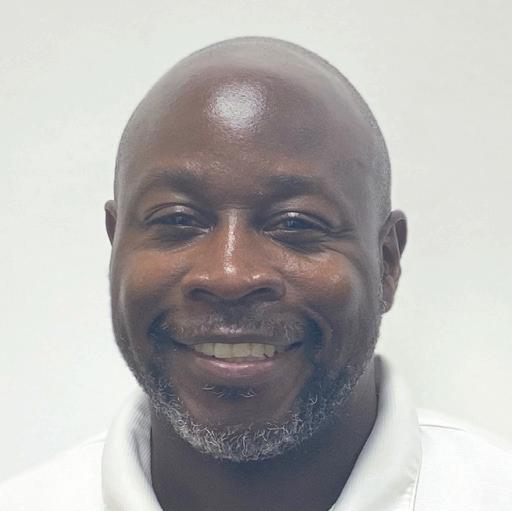
The Greenhill Athletics Department has been planning an event like this for three years. This year, the department’s plan finally came to fruition.
“The help of the people in this office really motivated me to continue with the process and not get discouraged by it,” Shine said.
There were several factors in consideration while planning the event.
“[We are] looking at the overall safety of everything, logistics of everything and then the overall fan experience,” Williams said.
Due to the competitive nature of the awards, the department wanted to ensure the event is inclusive and engaging for all students.
“Making sure that this is an equitable event for everybody is probably one of the most challenging things,” Williams said. “At the end of the day, we want this to be something that the students at Greenhill look forward to every year.”
The Athletics Department created various categories of awards. Featured awards will include Best Championship Performance, Best Moment and Outstanding Team.
“
“I’m pretty sure most of the students on our campus are athletes in some form or fashion. We would love for an entire student body to be there to support.”
“There’s a lot of different opportunities for people to be represented as well as the teams just being able to go up there themselves,” Williams said.
The department also decided on a process to determine
the winners. For each award, athletes and coaches will nominate players, and then the student body will vote on the nominees.
“We are going to open it up, just like we do for Athlete of the Week, for everyone to vote for these individual awards,” Shine said.
Williams says preparation for the event began at the end of the football season in November.
There will be a red carpet entrance and signs to make it as similar as possible to ESPN’s ESPYS awards.
“It’s going to be an opportunity for you to dress up,” Shine said. “There are going to be paparazzi people taking pictures.”
Another consideration that went into preparations was encouraging students to participate and attend the event.
The Upper School Athletics Board aided the Athletics Department throughout this process.
“It’s an opportunity for us to celebrate all of our athletes, whether it be team or individual accomplishments.”
“The Athletics Board has really put our input in and helped come up with ideas to communicate what’s happening to the student body and come up with creative ideas for the night,” senior board member Sophie Schwartz said.
Greenhill Athletics also collaborated with several students to create videos showcasing athletes.
Shine says that Athletic Department Coordinator Izayah Donnelly has been instrumental throughout the preparation process.
“He’s doing a lot of the heavy lifting in terms of researching and figuring out how to get the red carpet to look right,” Shine said.
Donnelly says he hopes the Greenhill ESPYS will also boost the motivation of athletes.
“I think once people see what it is and see the trophies and things like that, it may motivate them to say, ‘oh, I want an award like that’,” Donnelly said. “That’s the goal.”
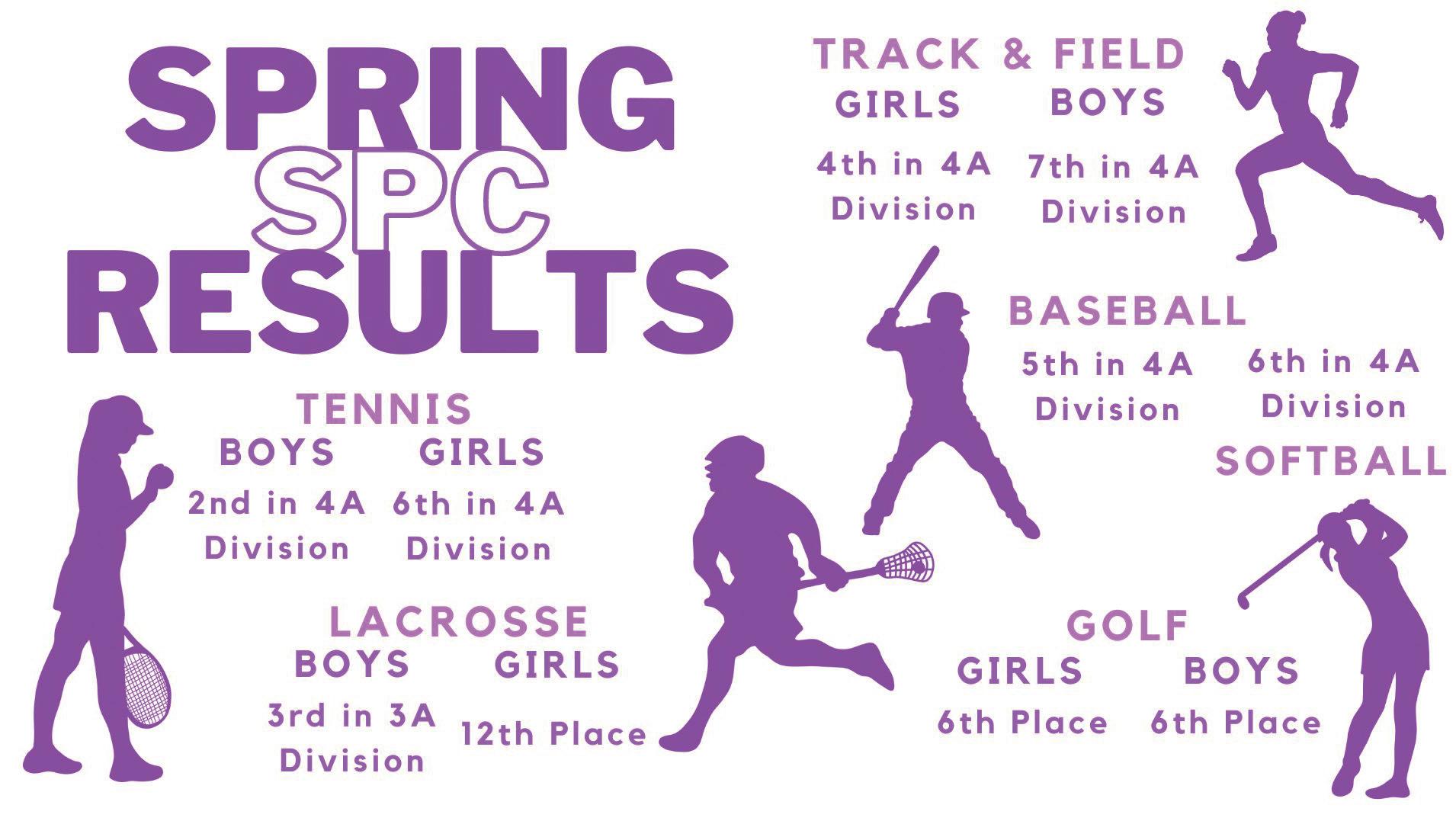
In recent years, college sports have been revolutionized, for better or for worse, by the decision to pay studentathletes for the use of their name, image and likeness.
The system of paying college athletes is commonly known as NIL, and now it’s beginning to change high school sports as well.
In a little more than two years, 35 states have passed legislation allowing NIL deals to sponsor high school athletes. Texas is among the holdouts, but the pressure to allow payments is expected to grow.
A larger question that hangs over the debate is whether payments to athletes hurt high school or college sports.
Former Greenhill football player Kassidy Woods ’18 believes that NIL deals will not have a negative impact on high school sports in Texas. Woods recently finished playing football for Auburn University and has declared for the NFL draft.
“The history has already been so engraved with Texas sports, and there are so many great athletes that are born and come from Texas,” Woods said. “I strongly believe that NIL is not going to take away from the culture of football and how athletes treat the game.”
On the opposing side, critics believe endorsements will encourage talented high school athletes in Texas to move to other states where NIL endorsements are allowed, creating a pay to play culture. This fear stems from the impact of the introduction of NIL deals in collegiate sports.
In the new NIL era, college student-athletes can make money in sponsorships with some of the biggest consumer brands.
“
I strongly believe that NIL is not going to take away from the culture of football and how athletes treat the game.”
During the 2021-2022 season, the first year of NIL, college athletes earned an estimated $917 million, according to Icon Source. This number will only climb as schools use these sponsorships to attract top talent and build successful programs.
“I believe big schools will have an advantage going forward,” junior Noah Piper said. “Money talks.”
Former University of Alabama Head Football Coach Nick Saban has said that NIL rules have damaged college sports. Saban coached during a time when NIL deals were banned in collegiate sports and then into the early years of its legalization.
“All the things that I believed in, for all these years, 50 years of coaching, no longer exist in college athletics,” Saban said during a Capitol Hill roundtable. “It was always about developing players; it was always about helping people be more successful in life.”
Greenhill Head Football Coach KJ Williams agrees with Saban’s remarks.
“There was a shift with social media taking over,” Williams said. “I don’t think he is over-exaggerating. I think [what he said] is true.”
Williams played Division I football at Sam Houston State University and Texas A&M University. He played when the rise of NIL was
anticipated but had not yet been implemented in college athletics.
Now, as a high school coach, Williams says he is directly exposed to the effects of NIL deals as many of his players have continued playing football at the collegiate level.
“I think it may help certain people in certain situations, maybe somebody from the inner city that needs to be able to help provide at home,” Williams said. “But I also think it may be tainting the integrity of the game.”
A commonly cited example of what Williams and others fear is centered around University of Texas at Austin quarterback Arch Manning, son of retired NFL Hall-ofFame quarterback Peyton Manning. Arch Manning’s NIL valuation stands at $2.8 million. On the other hand, Brock Purdy, a professional quarterback who led the San Francisco 49ers to the Superbowl, earned a salary of $870,000 during the 2023-2024 year.
“I think it may help certain people in certain situations, maybe somebody from the inner city that needs to be able to help provide at home. But I also think it may be tainting the integrity of the game.”
Even though Purdy is competing at a professional level, Arch Manning has tripled Purdy’s earnings via NIL deals. Some fear this will create a culture in which status and fame hold more weight than athletic achievement.
“Fame is definitely changing the game surrounding NIL,” Piper said. “These athletes with famous parents will have an advantage surrounding NIL as they come into college.”
Although there are many critics of NIL deals, Woods says it is important to look at NIL with an open mind.
“I believe we have approached NIL with a limited perspective to only be beneficial to drive and feed our own personal egos,” Woods said. “But it can do much more if these individuals think about how [NIL deals] can help others collectively, whether on their team, church, family, school or community.”
Woods says he believes NIL money is not harmful if athletes have the right intention and seek to help others.
“The passing of [NIL deals] has positively affected my college football career by allowing me to monetize my name,” Woods said. “More specifically, it has given

NIL: Graduating seniors who are set to play NCAA-level athletics will be eligible for NIL deals.
where I was able to receive protein shakes, vitamins and supplements at a discounted price for my teammates and me.”
“Fame is definitely changing the game surrounding NIL. These athletes with famous parents will have an advantage surrounding NIL as they come into college.”
Greenhill senior Devin Davis, who has committed to play soccer at the University of Tennessee, Knoxville, says she had NIL in the back of her mind during her college quest.
“Some [schools] were way more into NIL than others,” Davis said. “But I did meet with a NIL specialist on my visits,
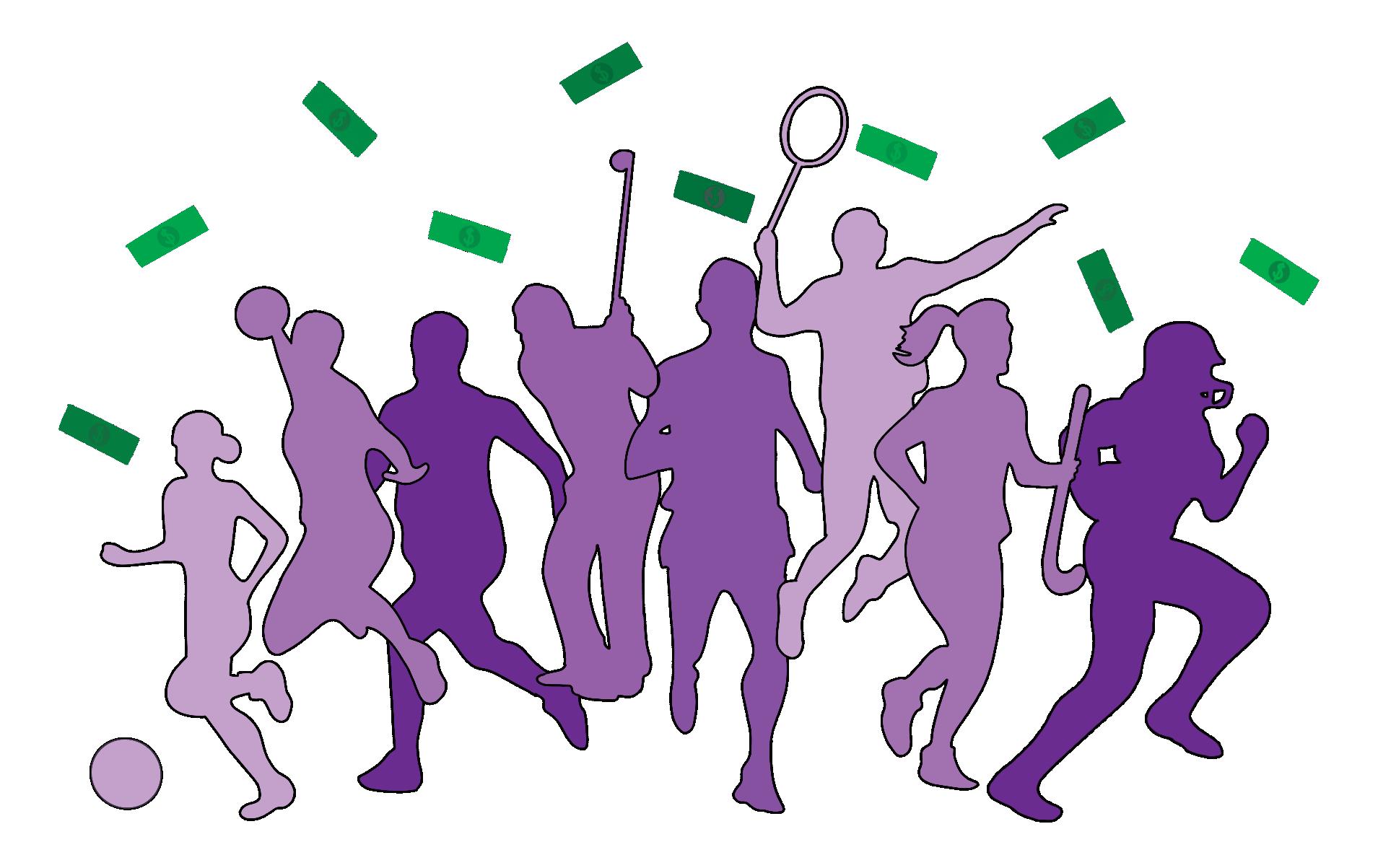
Davis is entering college when NIL is in full swing, and her recruiting experience is proof of how the payments are a topic of conversation for many high school athletes.
Negative or positive, NIL deals are the future of both collegiate and high school sports, and schools will need to adapt to stay relevant in the recruiting process.
“The biggest advantage is [that] content keeps changing daily,” Williams said. “There is always another deal to be made or another social media post to be shared.”
As NIL deals become more common for young athletes, many coaches emphasize the idea that athletes should not just compete for the sake of money and NIL deals.
“The betterment of one physically, mentally, emotionally and spiritually will come before partnerships and dollar signs,” Woods said.
In the past few years, student enrollment at Greenhill has steadily increased. Athletic fitness and training programs have also expanded, and that has strained the capacity of existing sports facilities.
Now, with the recent opening of the Valdes STEM + Innovation Center, Greenhill is poised to undertake a $28.2 million construction plan aimed at upgrading campus athletic facilities.
“Sometimes when multiple teams are scheduled to work out in the [High Performance Center], it can be difficult to have your own space during a workout,” junior Brynn Zawadzki said. “So, it is really exciting that there is a new facility on the way.”
The centerpiece of the plan will be a new Athletic Performance Center for indoor and outdoor workouts. Other components will include a multi-sport synthetic turf field and new tennis courts.

The Athletic Performance Center will house a new weightroom, locker rooms for outdoor sports, a concession stand, indoor areas to socialize, a viewing deck and satellite training facilities.
The performance center will be connected to the current turf practice field, which will serve as an extension of the training facility.
“There are going to be brand new stateof-the-art facilities no matter what sport you play,” Head of School Lee Hark said in an interview.
Hark offered a glimpse of the future in an email to families on Feb. 28. In his message, he explained that the next phase of the Growing Stronger Together fundraising campaign will facilitate the enhancement of Greenhill athletic programs.
“The hope is to not only improve the athletic experience of existing student athletes and coaches, but also attract families who may be interested in Greenhill for the athletic experience it will provide,” Hark said in his Evergreen interview.
In his email to families, Hark also talked about the scope and focus of the athletics initiative.
“As we started work on the STEM building, we also worked to identify the top priorities for athletics as well,” Hark wrote. “Over time, it became clear that our most critical need – and the facility that would have the greatest impact on our student body – was to expand the [High Performance Center].”
Associate Head of School Kendra Grace, who also serves as the school’s chief financial officer and chief operating officer, said in an email that the target is to “break ground on these projects in September.”
Once the Athletic Performance Center is finished, work will start on the new tennis courts. The long-term plan is to move the tennis courts to the southwest corner of campus. Until then, the current courts will remain in use.
After the tennis courts are completed, a new regulation-size turf field will be constructed.
“We feel like our students should have a space to fully optimize their potential,
especially those who want to play in college,” said Director of Sports Performance Jessen Houston. “We wanted to make sure we have a space to fully facilitate that.”
Many student athletes spoke favorably about the plans.
“I am really excited that Greenhill athletes are going to be able to use these new facilities,” junior Jenna Travers said. “I think that it will strengthen the sports programs here.”
School administrators and members of the Athletic Department have used the construction and design process to find ways to improve the most important aspects of the current sports facilities. Along with this, the Athletic Department is aiming to bring the community together and create a better environment for sports at Greenhill, according to Hark and Grace.
“These [facilities] are an opportunity for us to continue to strengthen the community,” said Hark in the Evergreen interview.
One of the ways that the new facilities will build community is through bridging the gender inequality gap in sports.
Currently, there are some disparities in the facilities that female and male athletes at Greenhill use. Hark says the new facilities should create a more equitable environment.
“We tried to be very thoughtful about the locker room facilities that we are providing,” Hark said in the Evergreen interview. “We wanted there to be no differences for what we were providing girls and boys field sports.”
The arrangement of the new facilities will allow all sports to practice on the west
side of campus together, something that isn’t possible now with the scattered layout of campus athletic fields and practice facilities. The new synthetic-turf field will also allow all sports to be played on the same side of campus.
The new layout will help build community among Greenhill athletes, according to Head of Athletics and Physical Education Jarrett Shine.
Another anticipated benefit of the new synthetic-turf field will be a higher level of practice and game play, especially during inclement weather.
“Since the ball moves slower on grass, the new fields will allow us to play quicker and better field hockey,” said sophomore varsity field hockey player Valentina CasasSayek.
The planning phase has been a collaborative effort involving Greenhill sports administrators and coaches.
“We’ve been discussing, brainstorming and planning these facilities for the better part of the last three years.” said Hark.
One significant long-term benefit that the athletics upgrade is expected to produce is the cultivation of alumni pride and projection of Greenhill’s vision, according to Hark.
“When Bernard Fulton founded Greenhill in 1950, his ambition was for Greenhill to be the best school in the nation,” Hark wrote in the February email to families. “It is an honor and a privilege to continue the work he started 75 years ago. This [athletics] campaign will help move us closer to that goal.”

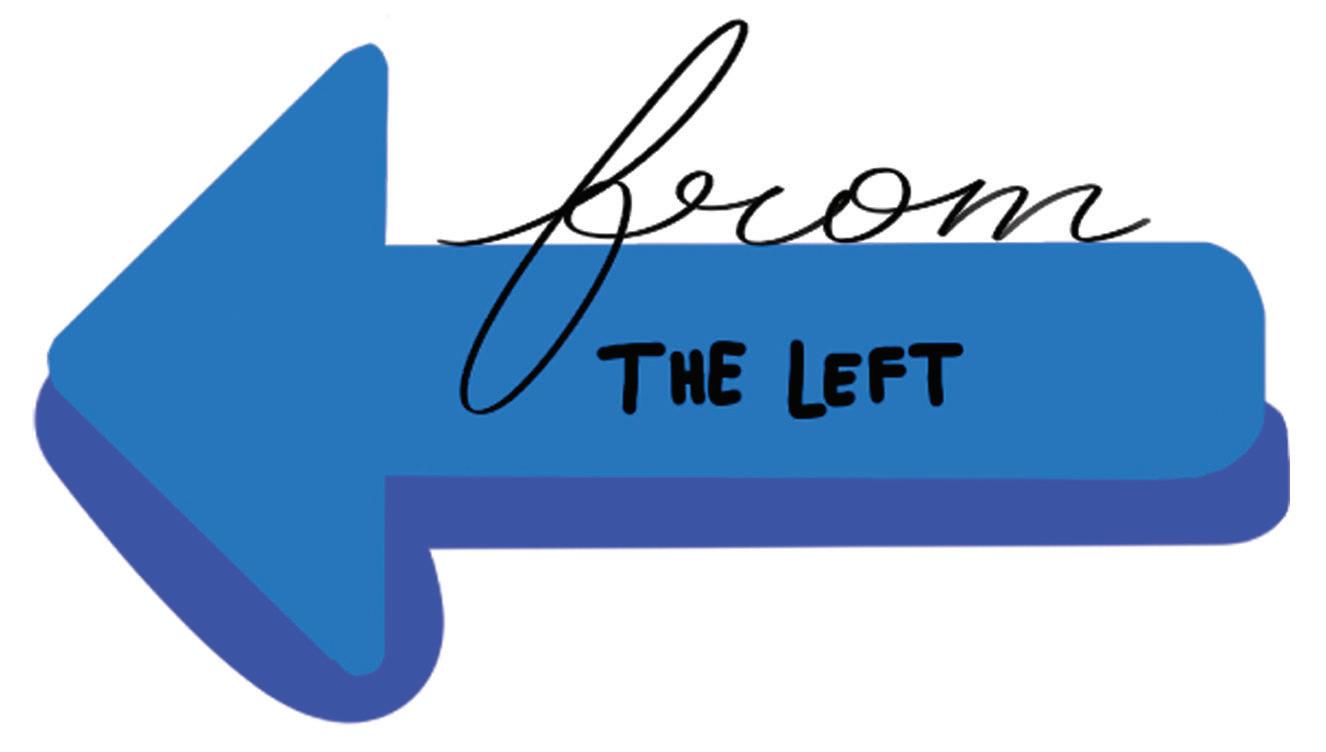
Texas Senate Bill 4, an extreme piece of immigration legislation that arose from a panicked Texas struggling to curtail the situation at the border, had the potential to change immigration laws in the United States forever.
Fortunately, S.B. 4 has rightfully been struck down by a U.S. appeals court.
Prior to this, the U.S. Supreme Court, which leans Republican, voted 6-3 to allow S.B. 4 to go into effect. To the relief of many across the country, myself included, the U.S. 5th Circuit Court of Appeals in New Orleans deemed S.B. 4 unconstitutional almost immediately after the Supreme Court decision, effectively zeroing out the bill.
If enacted, this bill would allow local and state law enforcement to arrest, detain and deport people that are suspected of entering the United States by crossing from Mexico into Texas without federal authorization.
Even though S.B. 4 was eventually struck down, it still sets an incredibly dangerous precedent, especially for people of color. To enforce the bill, people would have to reveal their immigration status to law enforcement, which is a slippery slope toward racial profiling.
This could pose threats to many existing residents in the U.S. who are brown or Black, as they could be accused based solely on their race or ethnicity. It seems many American lawmakers believe that a solution to the immigration crisis will somehow come from legislation that questions the citizenship of millions of people in the U.S.
With the 2024 elections on the horizon and a candidate who has been very outspoken with racist remarks, it’s not looking too good. This bill could very well be a quick sneak peek into the types of legislation we might see going forward, especially if former president Donald Trump is elected again.
S.B. 4 is also one of the most recent offenses in Texas’s long history of trying
to usurp the federal government, which continues to push the lines between state and federal jurisdiction. Immigration has always been a federal issue – the TexasMexico border, after all, is quite literally the U.S.-Mexico border – and it makes little to no sense why Texas feels as though they have the right to enforce such harsh legislation outside their jurisdiction.
Regardless of political orientation, the situation at the border must be resolved. The system we have now is clearly broken –families are being separated and people are being forced to wait with no knowledge of their asylum-seeking status and the border wall is causing more issues than ever.
However, the excessive force that is currently being used is a poor strategy. It only increases the chaos and the political divide surrounding illegal immigration, which further polarizes both sides of the political spectrum when trying to solve the issue.
There’s no perfect solution. There never will be. But there has to be a better option, something that can avoid pushing millions of families into living in fear of law enforcement, the very entity that exists to protect them.
If bills like S.B. 4 continue to be introduced and passed, we will begin to regress into the time when every person of color was seen as a threat.
In the future, I hope that things look different, and many people agree on both sides of the political divide. Kate Melloy Goettel, the senior legal director at the American Immigration Council, sums it up best:
“Rather than pushing inhumane bills that result in persecution and abuse for immigrant families, state and local governments should focus their energy on working with federal authorities to coordinate receiving migrants at the border. We have a blueprint for fixing outrbroken immigration system, and politically motivated and hateful laws like S.B. 4 don’t solve any of our root problems. It only creates more chaos.”
Senate Bill 4 is a solution, but is it the best one?
For border states like Texas, the inability to accurately determine whether immigrants have entered the country legally has proven to be a challenge. Texas has sought to alleviate part of this issue by allowing law enforcement agencies to check citizenship through the enforcement of Senate Bill 4.
S.B. 4, which was signed into law by Gov. Greg Abbott in December, but temporarily blocked by a federal appeals court, aims to require states to comply with federal immigration laws by withholding state grants for noncompliance. The law would also allow the Texas attorney general to take legal action against agencies and individuals for not enforcing immigration laws.
The legislation would empower law enforcement officers in Texas to ask individuals to disclose their citizenship status.
Conservatives contend that illegal immigration constitutes an invasion and that states are empowered by the 10th Amendment of the U.S. Constitution to defend themselves from an invasion. Based on this interpretation of the Constitution, many Texas conservatives contend that S.B. 4 is justified.
We believe this stance puts Texas in conflict with the 14th Amendment’s equal protection clause by inadvertently resulting in discriminatory practices. Law enforcement could target individuals based on race or ethnic background under the guise of verifying and questioning immigration status.
This would erode trust between communities and law enforcement, which could deter effective community policing and safety.
Additionally, the law's focus on stringent penalties for non-compliance by local law enforcement might drain communities of resources needed for other community safety efforts. Such
redirection of focus and funds could result in a net decrease in overall public safety, contradicting the legislation's intended purpose.
While we believe that S.B. 4 might inadvertently lead to unfair practices, we also think that the situation at the border is dire. In December 2023 alone, there was a 31% increase in illegal border crossings in south Texas. To help stem this flow of illegal immigration, Governor Abbott and Texas senators have allocated around $4 billion within the last two years for border enforcement.
The problem of illegal immigration is an undeniably complex issue that requires effective management. Any solution should weigh constitutional rights and utilize humane and fair methods that reinforce public trust and safety.
We believe that legislation should strengthen cooperation between federal and state agencies, but that requires the federal government to do more to secure the southern border. Additionally, the federal government should provide more support to struggling states to prevent legislation like S.B. 4 from being introduced in the first place.
As it stands now, Texas is slowly being drained of resources as conditions around the border worsen. Immediate action must be taken to combat this, and S.B. 4 is a step in the right direction when it comes to expressing the need for federal help. This particular piece of legislation is flawed, but it has forced the federal government to pay closer attention to the Texas border.
Action must be taken to secure the southern border, and the federal government must provide more support and must enforce existing rules. Federal regulations thus far are not comprehensive enough to suit the needs of border states like Texas. Current measures fall short in addressing Texas's escalating border crisis. In short, it’s clear that a more strategic, robust federal approach is urgently needed to secure and support Texas.

15, 2024
n the past year, the two of us have learned so much from the Evergreen.
To us, the Evergreen is more than just a school newspaper – it’s a community where we have created lasting memories and a publication that we are truly proud of.
To our section editors, Rory, Lyna, Kate, Noor, Nora, Justin, Vedant, John and Sasha, you guys have grown so much this year. InDesign is not an easy program to understand, but you guys took the time to master it and made layout fun. Special shout out to Sasha for handling a section all by herself and coming up with creative Rants and Raves!
To our editing team, Evie, Aria, Aman and Sydney, thank you for always being up to edit stories, no matter how last-minute and complicated they were. We know editing Centerpiece is never fun, but you guys embraced the challenge.
To our photography staff, thank you for taking headshots at the last minute. Ella, your editing skills have improved so much over the last year, even when we had to change the photo settings so many times.
Dani and Lyna, thank you for always being pillars of support. Your dinner table laughs will always be fond memories. You guys are up to do any job no matter the situation. We know you guys will kill it next year with brainstorming and content.
Varun, where do we even begin? In your own way, you are one of the most special parts of the Evergreen. Though it took you a few issues to learn how to layout the Middle School page, we know you can do anything you put your mind to. We will miss your basketball commentary and your NLE Choppa rap sessions.
Chloe, our beloved happy warrior. You really did it all this year. Whether it was staying up on weekends to edit photos or designing graphics, you did it all with a smile on your face. Thank you for always being so positive even in the face of adversity.
Christan, you really are the backbone of the Evergreen. Wellwritten stories matter to a newspaper, but design is just as important. Your innovative ideas have taken the Evergreen to the next level. We are continually impressed with your cover designs and artwork. Thank you for always being so kind and patient with the rest of us,

even when we don’t always know what we’re doing.
Sophia, when you weren’t at a debate tournament in Croatia or some other exotic place, you really were one of the most integral parts of layout. Our sometimescontroversial staff editorial would not be where it is if it wasn’t for you. We really appreciate all the work you put in for the editing team and your moral support during layout.

Payton, even though this was your first year on print, we could always rely on you because of your willingness to help and try anything. It didn’t matter what story or what interview we needed help with, you were always the most adaptable. We will really miss the positive energy and laughs you bring to layout. We couldn’t have done it without you.
Emily, our InDesign expert. The paper would have never been submitted each layout if it wasn’t for you. We will never forget you hunching over your laptop, with your AirPods blasting Taylor Swift, constantly screaming about white space. Thank you for always staying late and being up for anything.
To the future editors, Evie and Aria,
we know you can handle the challenge of being in charge of the paper. It’s difficult, and there are times you will want to scream and cry, but you guys can do it. Remember to rely on the support of the others around you and to talk to each other. Everyone on the staff is here to help each other and there’s still so much more to learn. It’s okay to feel like you’re doing everything wrong because something will always go wrong. In reality, you’re doing just fine.
Mr. Jones, thank you for everything. Thank you for taking a chance on us and guiding us through the time we’ve had in journalism. We’ve discovered a passion that has turned into something so fruitful and rewarding. Thank you for being a trusted advisor whom we can always count on when we need to figure things out. We really couldn’t have done any of this without you.
To everyone who has contributed to Evergreen in some way, whether through writing, photography, graphic design, or even just picking up a copy to read it: thank you. We are so proud that we had the opportunity to contribute to a longstanding paper that is so beloved in the Greenhill community. Thank you so much for letting us lead the Evergreen for the past year.
Signing off,
Riya and Pooja, The Evergreen Editors-inChief, 2023-2024
The editorial from the April edition called for equalizing AP courses by either eliminating the AP program or adding more humanities AP courses; while I sympathize with the cutthroat nature of the college application process, I believe this editorial has drawn faulty conclusions and highlighted a non-existent problem. Students cannot be penalized for not taking courses that are not offered; rather, students benefit from pursuing their passions.
The editorial points out that Greenhill offers a vast array of course electives. Classes such as International Relations, Multicultural Poetry and Astronomy are what make a Greenhill education stand out. When I talk to teachers from other schools, they are awed by the depth and breadth of our offerings. Greenhill electives expose students to material that they might not otherwise see until graduate school. For example, in Independence Struggles in the Non-Western World, we read Gandhi and Frantz Fanon who challenge students to rethink their basic assumptions about the world. These courses delve into monographs and scholarly articles.
Many also have extensive research and writing components. They are modeled on college courses, and they prepare students to be successful in the college classroom. Our Global History and US History classes emphasize project-based learning, research
and writing. They are designed to give students essential skills in and beyond the history classroom. These classes set apart a Greenhill education.
On the other hand, AP humanities courses have limitations. They are content heavy and move at breakneck pace, making depth impossible. College professors design their own courses and pick and choose which events and people to include, but AP teachers must follow a course guide which forces them to do all the material. Students typically do not read whole works or scholarly essays; they read excerpts of documents without context.
Additionally, students are taught to write to a highly specific rubric. This makes the essays easy to grade, but frankly it is poor writing. For example, while I tell my students in US History to include textual evidence, on the AP exam they are penalized for using direct quotations. The rubric requires students to have a thesis, but it does not have to be good, and students do not have to prove it. AP writing values conformity and goes against everything we teach them in other classes. Your editorial states “Neglecting the humanities in the AP curriculum deprives students who have interests in literature, history, philosophy and the arts of the opportunity to challenge themselves at an advanced level.” On the contrary, our electives help people push
themselves and discover new interests, skills, and passions.
AP courses threaten the electives that are the hallmark of the Greenhill humanities departments. Recent upticks in AP Government and AP European enrollment have led to the loss of electives. Classes such as World Religions, Globalization and Food History, LGBTQ History, and War at Home: the WWII Homefront were all canceled to make way for more sections of AP courses. The reason we set a limit on the number of AP courses is not to hold students back. Rather we have established those rules because we do not have enough faculty to expand the AP program.
More importantly, we are protecting the part of our program that we believe most effectively prepares students for college. You ask that Greenhill create an environment “where students feel empowered to pursue their passions and explore diverse interests.” This is exactly why the History Department does not want to add any more courses that simply teach to a standardized test.

Upper School History Department Chair Dr. Amy Bresie is a proud alumna of Greenhill School and has been teaching in the History Department since 2014.
Have a response? Opinion?
kuttya25@greenhill.org kweie25@greenhill.org
EDITORIAL POLICY
The Evergreen is an independent, student-run newspaper serving the Greenhill School community. It is printed six times during the school year. Print circulation is 900 copies. Past issues are archived at issuu.com/ghevergreen. Our staff upholds a code of ethics that values honesty, integrity, accuracy and responsibility. Our mission is to help our community interpret campus, local, state and national events through content written and edited by students.
The Evergreen welcomes letters and emails from readers. We reserve the right to edit submissions for accuracy, grammar and length. The Evergreen will not publish material that we judge to be libelous, or obscene, invades privacy or constitutes hate speech. The staff editorial represents the opinion of The Evergreen staff, not necessarily that of Greenhill School.
ADVERTISEMENTS
The Evergreen welcomes all advertisements, but we reserve the right to refuse an ad.
Business inquiries should be directed to Ella Sadka: sadkae26@greenhill.org
CORRECTIONS & CLARIFICATIONS
To request a correction or clarification, please email kuttya25@ greenhill.org or kweie25@greenhill.org
CORRECTION – MAY 2024 ISSUE
The staff editorial in the April 2024 issue incorrectly stated that “the only AP classes offered at Greenhill are STEM APs and two AP history classes.” Four other non-STEM AP courses are offered: AP 2D Art, AP Spanish Language and Culture, AP Chinese and AP Latin.

A RAVE to playoff season for Dallas sports teams. Both the Dallas Mavericks and the Dallas Stars made it to the post-season this year, and we have loved seeing them compete at the highest level. The American Airlines Center has been rowdy, loud and proud lately!
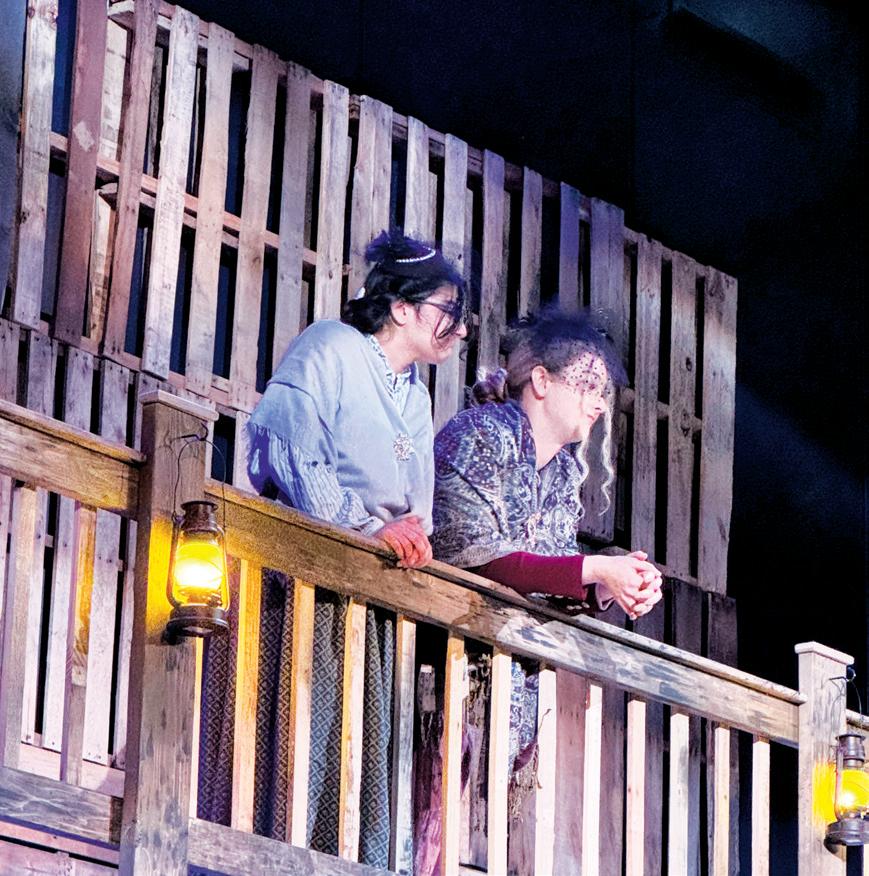
A RAVE to the “Much Ado about Nothing” production. After weeks of preparation, the cast of the spring play had three successful shows. Each one was sold out, and the ISAS show had a line of hundreds of people who wanted to attend!
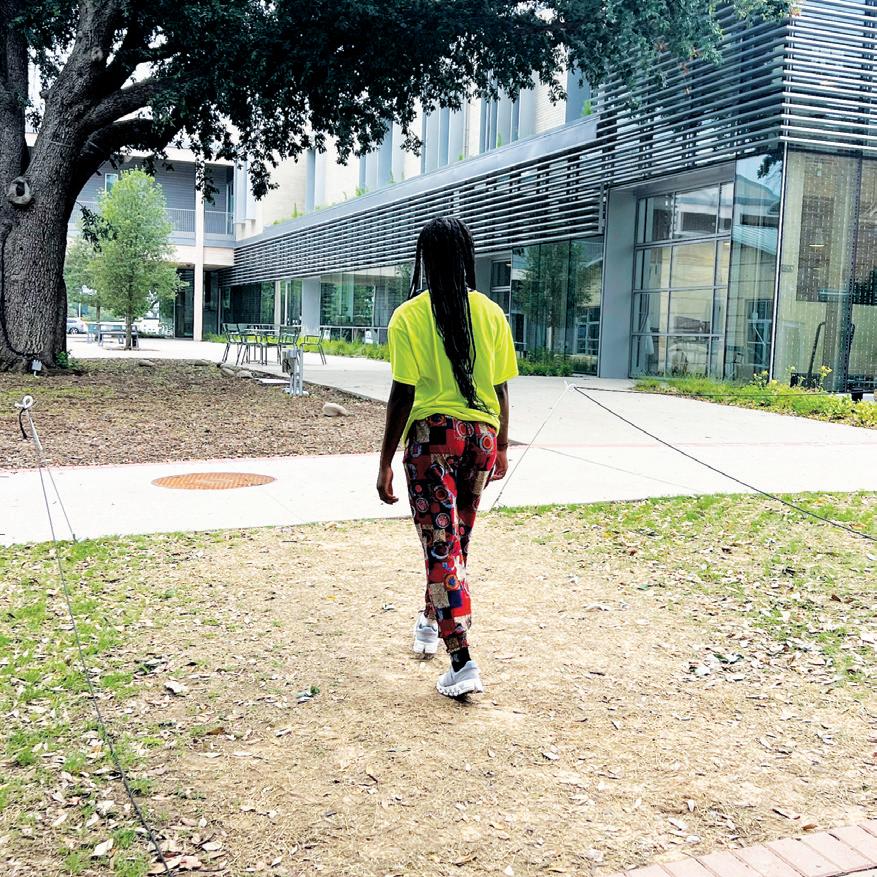
A RANT to the sidewalk design at the VSI. When coming from the Upper School, students must walk through the grass to get to the main entrance. As you can imagine, on a rainy and muddy day, this is not ideal.

A RANT to Advanced Placement season. As the school year comes to an end, instead of getting excited for summer, students are hard at work studying for AP exams. We cannot wait until May 17 when the last AP test is done so that we can be free!
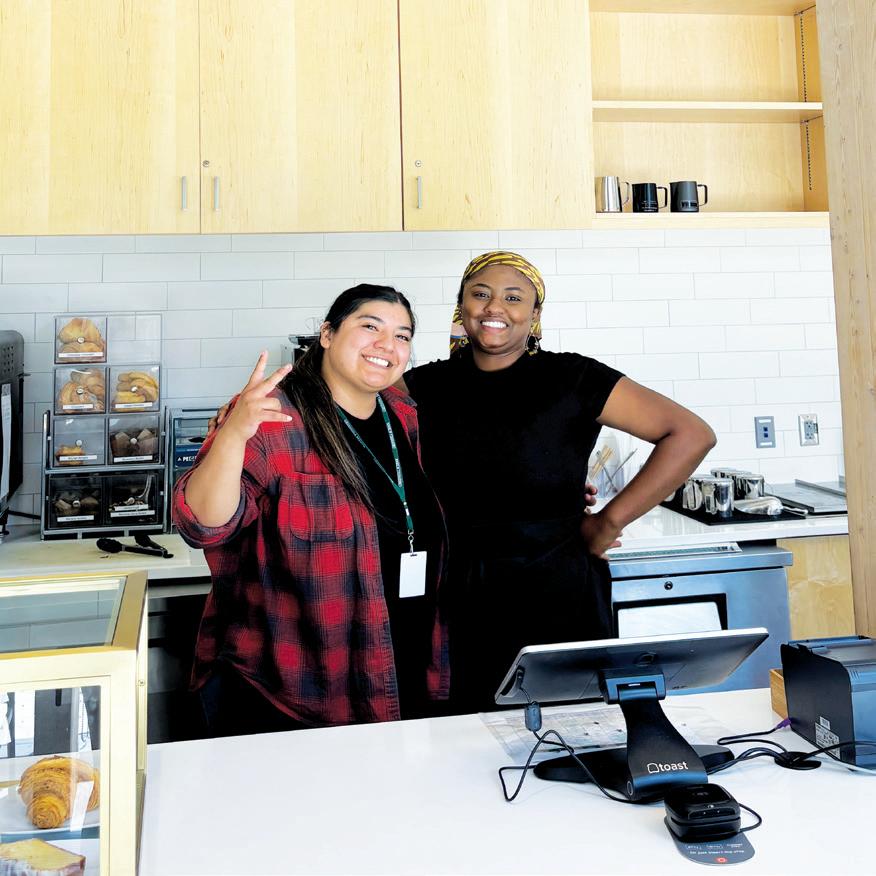
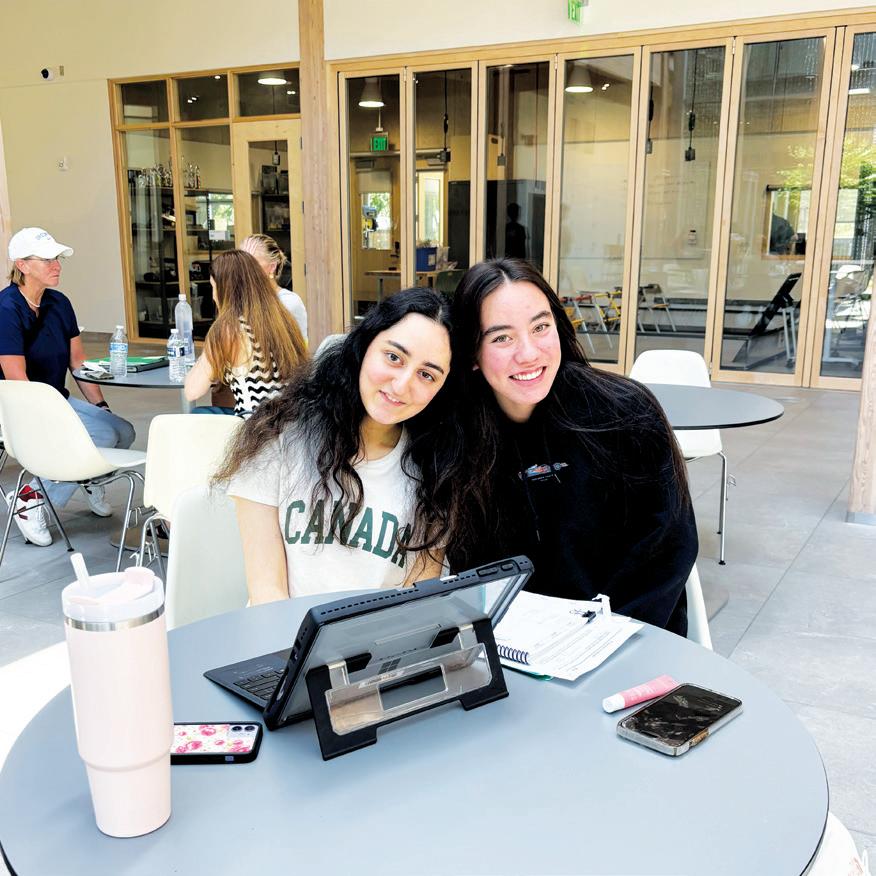
are so excited to finally have some free time in the summer where we can travel and spend time with our friends, we are going to miss seeing our classmates and teachers every day. HAGS!
Every year, Upper School seniors have the opportunity to embark on a year-long, self-led exploration of a topic of their choice. These are known as Capstone projects.
Once a topic is chosen, a student must find an oncampus mentor. They are also encouraged to find an offcampus mentor.
The course culminates in the spring in a final presentation before Upper School students and faculty.
“Folks should see it as a passion project that is studentdriven and very much self-designed,” said Director of Academics Jason Yaffe. “It doesn't mean that they're doing this work alone. They have different layers of support, whether it's from fellow Capstone students, an on-campus advisor or an off-campus advisor.”
The Capstone is designed so students can dive deeply into something that interests them. Most topics are crossdisciplinary, which Yaffe says is one of the main reasons why the project is unique.
This year, eight seniors completed a Capstone project, with topics involving many different areas of study.
The Evergreen spoke to Yaffe and seniors who are currently doing a Capstone. Here is a lightly edited transcript of what they had to say about their experiences and the keys to success in a Capstone:
Why did you choose to do a Capstone project?
“My junior year, I got to take the post-AP [Honors] Spanish Literature class here, and that was taught by [Luis] Gallegos and I kind of fell in love with Spanish literature. I found it really interesting, and I knew from then that I really wanted to continue exploring Spanish literature.”
– senior Anika Mootha, whose project focuses on four female poets from the Spanish-speaking world
“I wanted to do a Capstone because I wanted to see my summer research through and have the opportunity to take a self-driven approach to research.”
– senior Pooja Sanghvi, who is continuing her research on leukemia cells that she began last summer at the UT Southwestern STARS Summer Research Program
What’s your favorite part of doing a Capstone project?
“My favorite part about doing a Capstone is getting to pursue something I’m passionate about. It’s really cool to get to brand myself and put myself out there as part of a Capstone, because I would never get this experience in a typical classroom setting.”
– senior Sibelle Zambie, who is researching the process of brand building and personal marketing
“I've really enjoyed kind of getting to choose what exactly I get to learn about, so I realized that I really love the work of these four specific poets. Having the autonomy to dive into their specific works has been really fun.”
– senior Anika Mootha
“My favorite part of researching in a lab is gaining a new perspective on the science that I learned throughout my junior year. As I work with cell metabolism, I have gotten to see how biology and chemistry intertwine.”
– senior Pooja Sanghvi
What are some challenges that you have faced throughout the year?
“The most challenging aspect is definitely balancing working at the lab with my schoolwork and meeting with my school mentor. I feel like there is always something more I can contribute to at the lab, making any amount of time not enough.”
– senior Pooja Sanghvi



“You really have to manage your time and have goals throughout the process, so that was kind of a challenge to begin with.”
– senior Anika Mootha
What qualities would help students succeed in a Capstone project?
“I think a student who wants to be successful in pursuing a Capstone needs to be self-driven and motivated.” – senior Pooja Sanghvi
“I think they’re thinking differently. They’re thinking across disciplines. They're thinking about questions that they may have had a little bit of a taste of in a previous class and want to explore further. I think it’s just the skill of being a curious person.”
– Director of Academics Jason Yaffe
What advice do you have for students who are interested in doing a Capstone project in the future?
“I would say try to involve your in-school mentor as much as possible. Also, time management was the most challenging aspect for me, so make sure you have set goals throughout the entire year that you can kind of mark off.”
– senior Anika Mootha
“Don’t be afraid to pursue something you are passionate about, even if it’s foreign to you. You don’t have to be a master in your subject to apply for a Capstone, you just have to be passionate about it and willing to put in the work.”
– senior Sibelle Zambie


student studying abroad
students studying on the West Coast

American University (1)
Austin College (1)
Austin Community College (1)
Babson College (1)
Baylor University (1)
Boston University (1)
Butler University (1)
Centre College (1)
Cornell University (2)
Dartmouth College (2)
Drexel University (1)
Duke University (4)
Elmhurst University (1)
Elon University (1)
Emory University (2)
Indiana University (4)
38 students staying in Texas
Johns Hopkins University (1)
Lehigh University (1)
Massachusetts Institute of Technology (1)
Mercer University (1)
Miami University (1)
Montana State University (1)
New York University (1)
Northeastern University (5)
Pepperdine University (1)
Pomona College (1)
Purdue University (3)
Rensselaer Polytechnic Institute (1)
Rhodes College (1)
Rice University (4)
Southern Methodist University (5)
Stanford University (1)

Syracuse University (2)
Texas Christian University (1)
The University of British Columbia (1)
The University of North Carolina (1)
The University of Texas at Arlington (1)
The University of Texas at Austin (21)
The University of Texas at Dallas (1)
The University of Texas at Tyler (1)
Tufts University (2)
Tulane University (3)
University of California-Berkeley (1)
University of California-Los Angeles (1)
University of Chicago (1)
University of Colorado Boulder (1)
University of Georgia (1)
University of Houston (1)
students studying in the Greater Boston Area 36
students studying on the East Coast
0 students
1-3 students
4-9 students
10+ students
University of Illinois Urbana-Champaign (1)
University of Miami (3)
University of Michigan (2)
University of Notre Dame (1)
University of Oklahoma (2)
University of Pennsylvania (1)
University of Puget Sound (1)
University of Tennessee (1)
University of Utah (1)
University of Washington (1)
University of Wisconsin (1)
Vanderbilt University (2)
Washington University in St. Louis (2)
Yale University (1)
“Moments with Idevisory” Years unfurl, evolve— Old faces out, new ones in— Our circle reshaped. In lab space we grew, Holiday sweater aglow, Memories were made. Lens of joy captures, Polaroids freeze all our smiles— Laughter echoes still. Paths now diverge wide, Curiosity your guide— Bright futures await.
- Mr. Ide
Dear Advisory PEEPS,
Thomas Advisory,
Thank you so much for sharing this space together and allowing it to grow and become something special. It is special because you have made it so and learned to take care of each other. There is no formula for this, but it is everyday magic and essential for living a good life. As you move through life, it is my hope that you continue to create these spaces wherever you are. Bloom where you are planted! Gratitude to you all.
- Dr. Thomas
What a journey these past four years have been! From the early days of crazy Covid advisory hangouts, to concussions, to surgeries, to Just Dance parties, to VHS advisory fight club ( we all know who would take down whom), to VHS clearly taking down Quinn Graves with her astute red belt karate moves, to rebellious snack buying sprees, to losing people #WeLoveYou Eliza, Marina and Micah, to welcoming awesome new advisees shoutout to Anisa and Ayne, to an AMAZING TOTAL SOLAR ECLIPSE we shared just recently…and suddenly we are standing on the threshold of Graduation. I started writing this note smiling and lost in memories, but now I am crying. I want you to know that you made these past four years truly meaningful, that I am SO DANG PROUD of you all, and that I cannot wait to see how you will make a difference in the world.
USE YOUR POWERS FOR GOOD! Love you.
- VHS (Ms. Hauss-Smith)
Colvin Advisory:
Well friends, we made it to the end! I want to take a second to reflect on the unusual journey we all took together to reach this significant milestone. Starting a freshman advisory online, then hybrid, then in person posed challenges for us all. A couple of you were with me for a solid four hours every other day, and we saw each other at our best and at our lowest. Somehow, we emerged from it stronger, and our advisory bond continued to develop over the last two years. Next year, you will face new opportunities and develop new friendships, so please go forward with confidence and excitement. You will be missed.
With love and respect, - Dr. Colvin
Advisees,
Thank you for an awesome four years! If there’s one thing I’ve learned about you in our time together, it’s that you love a good game.
With that in mind, here’s one final Connections for you.
Enjoy!
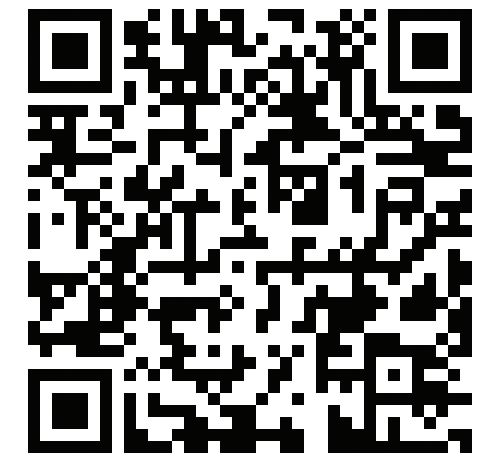
Warner Advisory,
What a ride it’s been! From our early days in virtual classes to spending hours together in Room 304 during freshman year, and then singing karaoke as a group at prom, looking back fills me with nostalgia and joy. Remember those times when we were all quiet, looking at our phones? It is amazing to see how much things have changed. Over the years, our advisory has seen members come and go, but it has been a privilege to watch you guys grow together as adults. It’s been an honor being your advisor. As you move forward, go after your dreams, achieve greatness and most importantly, find happiness.
- Mr. Warner
The Oros Advisory—
I am so glad that I am able to finish my Greenhill career with you as my advisory. When Ms. Garrett left, I saw the roster of the advisory, and was happy to take you on. It has been an exciting two years. You were always present, whether in my office, class meetings or assemblies—well, mostly. It warmed my heart that you enjoyed hanging out in the office, sharing each other’s ups and downs. I have loved your competitive spirit along with the fact that we won several of those competitions. While I know that you have enjoyed birthday treats, I have enjoyed baking them even more. I am proud of each of you and look forward to what your future holds. I hope to see you at alumni events.
- Mr. Oros
Dearest GarzAdvisory,
I know you all were a little skeptical sophomore year when I joined your advisory. I was also a little unsure but am so grateful that you let me be a part of your lives. It has been my true pleasure and honor to know you, watch you grow, and celebrate your accomplishments. I will miss our random discussions, individual talks, and the fun you bring to the library. I do not take these things for granted. I am so proud of you all and cannot wait to see the amazing things you will do! Please remember, you are enough. The library sloth and I will always be here with open arms and snacks. I will miss you terribly, but your time has come to shine! You’ve got the magic in you! So much love!
- Ms. Harrison
Dear Advisory,
Each moment with you has been a genuine joy. From the lively freshmen lunches of impromptu TikToks and competitive Imposter, to the library fireside chats and the “Pitch Perfect” karaoke, we’ve forged wonderful memories. Your care and love for each other is heartwarming and embodies the true meaning of family. Lean on these relationships, even as you expand your horizons. It has been an honor and privilege to be by your side for the last four years. Although we will miss you dearly, we are so proud to see you continue your journey into the world! Much Love Always!
- Ms. Kiang
Bon voyage! It’s time for you to go—in the best possible ways, we want you to go. Because it’s time for you to meet new friends, which sometimes means being the one to speak up or reach out first. Because it’s time for you to face new challenges, which sometimes means missing the target altogether. Because it’s time for you to be ambitious & brave, which sometimes means seeking out mentors that inspire &/or frighten you. You’re ready. And wherever you are, whatever you do, remember that there are people here who love you in your own individual ways—me included : ) Abrazos y cuidate, joel
- Mr. GarzaDear Khan Advisory,
Despite the initial shock and terror of realizing I would be spending the next four years with Max Meyer, you all, it is no secret that I was given the best advisory in the world. I truly enjoyed watching you all grow up from frightened freshman to confident collegiates (even through all the oversharing). I cannot wait to see all the amazing things each of you will accomplish in this next stage of life. It is truly a gift, and I hope it is everything you hope for, and more.
With all my love (and some tears), PS: Don’t forget about me when you hit it big.